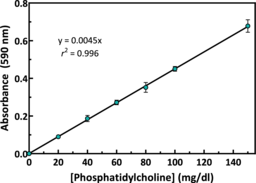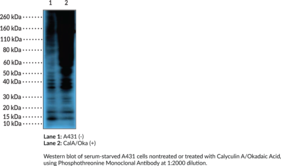Cayman
Showing 34951–35100 of 45550 results
-
Phenylpyropene A is a fungal metabolite originally isolated from P. griseofulvum that has enzyme inhibitory and insecticidal activities.{52149,52150,52151} It inhibits acyl-coenzyme A:cholesterol acyltransferase (ACAT; IC50 = 0.8 μM).{52149} Phenylpyropene A inhibits diacylglycerol acyltransferase (DGAT) in rat liver microsomes (IC50 = 78.7 μM). It induces mortality in 100% of M. persicae when used at a concentration of 5 ppm.{52151}
Brand:CaymanSKU:29594 - 5 mgAvailable on backorder
-
Phenytoin is a hydantoin anticonvulsant.{38720} It inhibits voltage-gated sodium channels in a voltage-dependent manner.{38721} Phenytoin reduces neuron firing in response to a depolarizing current in neurons from crayfish, Aplysia, rats, and mice when used at concentrations ranging from 20 to 100 μM. It also suppresses the persistent sodium current in a dose-dependent manner in rat neocortex without affecting the voltage-dependence of current activation.{38722} Phenytoin is oxidized by cytochrome P450 into several products that can lead to cell death in vitro and toxic effects in vivo, such as gingival hyperplasia and teratogenicity in rats and mice, respectively.{38720} In a rat model of status epilepticus, administration of phenytoin over 7 days (75 mg/kg, i.p., the first day, then 50 mg/kg per day) reduces seizure frequency and duration by 46 and approximately 20%, respectively, during the treatment period.{38723} In combination with the P-glycoprotein inhibitor tariquidar, phenytoin reduces seizure frequency by 93% but only for the first three days of the treatment period. Formulations containing phenytoin have been used in the treatment of status epilepticus.
Brand:CaymanSKU:24037 - 100 gAvailable on backorder
-
Phenytoin is a hydantoin anticonvulsant.{38720} It inhibits voltage-gated sodium channels in a voltage-dependent manner.{38721} Phenytoin reduces neuron firing in response to a depolarizing current in neurons from crayfish, Aplysia, rats, and mice when used at concentrations ranging from 20 to 100 μM. It also suppresses the persistent sodium current in a dose-dependent manner in rat neocortex without affecting the voltage-dependence of current activation.{38722} Phenytoin is oxidized by cytochrome P450 into several products that can lead to cell death in vitro and toxic effects in vivo, such as gingival hyperplasia and teratogenicity in rats and mice, respectively.{38720} In a rat model of status epilepticus, administration of phenytoin over 7 days (75 mg/kg, i.p., the first day, then 50 mg/kg per day) reduces seizure frequency and duration by 46 and approximately 20%, respectively, during the treatment period.{38723} In combination with the P-glycoprotein inhibitor tariquidar, phenytoin reduces seizure frequency by 93% but only for the first three days of the treatment period. Formulations containing phenytoin have been used in the treatment of status epilepticus.
Brand:CaymanSKU:24037 - 250 gAvailable on backorder
-
Phenytoin is a hydantoin anticonvulsant.{38720} It inhibits voltage-gated sodium channels in a voltage-dependent manner.{38721} Phenytoin reduces neuron firing in response to a depolarizing current in neurons from crayfish, Aplysia, rats, and mice when used at concentrations ranging from 20 to 100 μM. It also suppresses the persistent sodium current in a dose-dependent manner in rat neocortex without affecting the voltage-dependence of current activation.{38722} Phenytoin is oxidized by cytochrome P450 into several products that can lead to cell death in vitro and toxic effects in vivo, such as gingival hyperplasia and teratogenicity in rats and mice, respectively.{38720} In a rat model of status epilepticus, administration of phenytoin over 7 days (75 mg/kg, i.p., the first day, then 50 mg/kg per day) reduces seizure frequency and duration by 46 and approximately 20%, respectively, during the treatment period.{38723} In combination with the P-glycoprotein inhibitor tariquidar, phenytoin reduces seizure frequency by 93% but only for the first three days of the treatment period. Formulations containing phenytoin have been used in the treatment of status epilepticus.
Brand:CaymanSKU:24037 - 50 gAvailable on backorder
-
Pheophorbide a is a product of chlorophyll breakdown that has been used as a photosensitizer in photodynamic therapy for the treatment of cancer.{26143} It has been reported to inhibit U87MG cells with an IC50 value of 2.8 µg/ml and demonstrates cytostatic activity specifically against glioblastoma cells without affecting normal cells.{26144} It also displays antiproliferative activity against melanoma, breast, and lung cancer cells in vitro at 100 µg/ml.{26145}
Brand:CaymanSKU:- -
Pheophorbide a is a product of chlorophyll breakdown that has been used as a photosensitizer in photodynamic therapy for the treatment of cancer.{26143} It has been reported to inhibit U87MG cells with an IC50 value of 2.8 µg/ml and demonstrates cytostatic activity specifically against glioblastoma cells without affecting normal cells.{26144} It also displays antiproliferative activity against melanoma, breast, and lung cancer cells in vitro at 100 µg/ml.{26145}
Brand:CaymanSKU:- -
Pheophorbide a is a product of chlorophyll breakdown that has been used as a photosensitizer in photodynamic therapy for the treatment of cancer.{26143} It has been reported to inhibit U87MG cells with an IC50 value of 2.8 µg/ml and demonstrates cytostatic activity specifically against glioblastoma cells without affecting normal cells.{26144} It also displays antiproliferative activity against melanoma, breast, and lung cancer cells in vitro at 100 µg/ml.{26145}
Brand:CaymanSKU:- -
PHGDH-inactive is an inactive analog of the 3-phosphoglycerate dehydrogenase (PHGDH) inhibitors NCT-502 (Item No. 19716) and NCT-503 (Item No. 19718).{31375} Unlike the inhibitors, PHGDH-inactive does not inhibit PHGDH in vitro (IC50s = >57, 3.7, and 2.5 µM for PHGDH-inactive, NCT-502, and NCT-503, respectively), block serine synthesis in cells, or kill PHGDH-dependent cell lines.{31375} PHGDH-inactive is intended to serve as a negative control for NCT-502 and NCT-503.
Brand:CaymanSKU:19717 -Available on backorder
-
PHGDH-inactive is an inactive analog of the 3-phosphoglycerate dehydrogenase (PHGDH) inhibitors NCT-502 (Item No. 19716) and NCT-503 (Item No. 19718).{31375} Unlike the inhibitors, PHGDH-inactive does not inhibit PHGDH in vitro (IC50s = >57, 3.7, and 2.5 µM for PHGDH-inactive, NCT-502, and NCT-503, respectively), block serine synthesis in cells, or kill PHGDH-dependent cell lines.{31375} PHGDH-inactive is intended to serve as a negative control for NCT-502 and NCT-503.
Brand:CaymanSKU:19717 -Available on backorder
-
PHGDH-inactive is an inactive analog of the 3-phosphoglycerate dehydrogenase (PHGDH) inhibitors NCT-502 (Item No. 19716) and NCT-503 (Item No. 19718).{31375} Unlike the inhibitors, PHGDH-inactive does not inhibit PHGDH in vitro (IC50s = >57, 3.7, and 2.5 µM for PHGDH-inactive, NCT-502, and NCT-503, respectively), block serine synthesis in cells, or kill PHGDH-dependent cell lines.{31375} PHGDH-inactive is intended to serve as a negative control for NCT-502 and NCT-503.
Brand:CaymanSKU:19717 -Available on backorder
-
PHGDH-inactive is an inactive analog of the 3-phosphoglycerate dehydrogenase (PHGDH) inhibitors NCT-502 (Item No. 19716) and NCT-503 (Item No. 19718).{31375} Unlike the inhibitors, PHGDH-inactive does not inhibit PHGDH in vitro (IC50s = >57, 3.7, and 2.5 µM for PHGDH-inactive, NCT-502, and NCT-503, respectively), block serine synthesis in cells, or kill PHGDH-dependent cell lines.{31375} PHGDH-inactive is intended to serve as a negative control for NCT-502 and NCT-503.
Brand:CaymanSKU:19717 -Available on backorder
-
Philanthotoxin 74 (PhTx-74) is a synthetic analog of the naturally-occurring wasp venom toxin philanthotoxin-4,3,3. It is a subtype-selective AMPA receptor antagonist that inhibits homomeric GluR1 and GluR3 as well as heteromeric GluR1/2 receptors (80-100% of glutamate-evoked currents inhibited at 100 µM). It exhibits minimal to no effect on monomeric GluR2 or heteromeric GluR2/3 receptors at concentrations up to 500 µM.{23500} PhTx-74 inhibits the GluR5(Q) receptor with a Ki value of 0.29 µM.{23501}
Brand:CaymanSKU:- -
Philanthotoxin 74 (PhTx-74) is a synthetic analog of the naturally-occurring wasp venom toxin philanthotoxin-4,3,3. It is a subtype-selective AMPA receptor antagonist that inhibits homomeric GluR1 and GluR3 as well as heteromeric GluR1/2 receptors (80-100% of glutamate-evoked currents inhibited at 100 µM). It exhibits minimal to no effect on monomeric GluR2 or heteromeric GluR2/3 receptors at concentrations up to 500 µM.{23500} PhTx-74 inhibits the GluR5(Q) receptor with a Ki value of 0.29 µM.{23501}
Brand:CaymanSKU:- -
Phillygenin is a lignan that has been found in F. fructus and has diverse biological activities.{56162,56063,56164,56165} It scavenges peroxide and 2,2-diphenyl-1-picrylhydrazyl (DPPH; Item No. 14805) radicals in cell-free assays (IC50s = 10.5 and 19.1 µM, respectively).{56162} Phillygenin (25-200 µg/ml) inhibits LPS-induced production of IL-1β, IL-6, TNF-α, and the fibrosis markers collagen I and α-SMA in LX-2 hepatic stellate cells.{56063} It inhibits the growth of SH-1-V1 esophageal cancer cells (IC50 = 6 µM), as well as induces the production of reactive oxygen species (ROS) and apoptosis in the same cells.{56164} Phillygenin (15 mg/kg) reduces tumor volume in an SH-1-V1 mouse xenograft model. It also reduces serum levels of alanine aminotransferase (ALT), aspartate aminotransferase (AST), superoxide dismutase (SOD), and malondialdehyde (MDA) and prevents hepatic necrosis in a mouse model of carbon tetrachloride-induced liver injury.{56165}
Brand:CaymanSKU:30698 - 10 mgAvailable on backorder
-
Phillygenin is a lignan that has been found in F. fructus and has diverse biological activities.{56162,56063,56164,56165} It scavenges peroxide and 2,2-diphenyl-1-picrylhydrazyl (DPPH; Item No. 14805) radicals in cell-free assays (IC50s = 10.5 and 19.1 µM, respectively).{56162} Phillygenin (25-200 µg/ml) inhibits LPS-induced production of IL-1β, IL-6, TNF-α, and the fibrosis markers collagen I and α-SMA in LX-2 hepatic stellate cells.{56063} It inhibits the growth of SH-1-V1 esophageal cancer cells (IC50 = 6 µM), as well as induces the production of reactive oxygen species (ROS) and apoptosis in the same cells.{56164} Phillygenin (15 mg/kg) reduces tumor volume in an SH-1-V1 mouse xenograft model. It also reduces serum levels of alanine aminotransferase (ALT), aspartate aminotransferase (AST), superoxide dismutase (SOD), and malondialdehyde (MDA) and prevents hepatic necrosis in a mouse model of carbon tetrachloride-induced liver injury.{56165}
Brand:CaymanSKU:30698 - 25 mgAvailable on backorder
-
Phillygenin is a lignan that has been found in F. fructus and has diverse biological activities.{56162,56063,56164,56165} It scavenges peroxide and 2,2-diphenyl-1-picrylhydrazyl (DPPH; Item No. 14805) radicals in cell-free assays (IC50s = 10.5 and 19.1 µM, respectively).{56162} Phillygenin (25-200 µg/ml) inhibits LPS-induced production of IL-1β, IL-6, TNF-α, and the fibrosis markers collagen I and α-SMA in LX-2 hepatic stellate cells.{56063} It inhibits the growth of SH-1-V1 esophageal cancer cells (IC50 = 6 µM), as well as induces the production of reactive oxygen species (ROS) and apoptosis in the same cells.{56164} Phillygenin (15 mg/kg) reduces tumor volume in an SH-1-V1 mouse xenograft model. It also reduces serum levels of alanine aminotransferase (ALT), aspartate aminotransferase (AST), superoxide dismutase (SOD), and malondialdehyde (MDA) and prevents hepatic necrosis in a mouse model of carbon tetrachloride-induced liver injury.{56165}
Brand:CaymanSKU:30698 - 50 mgAvailable on backorder
-
Phillyrin is a lignan that has been found in F. suspense and has diverse biological activities.{48853,48854,48855,48856,48857} It reduces hydrogen peroxide-induced caspase activation, increases in malondialdehyde (MDA) levels, and production of reactive oxygen species (ROS), as well as increases glutathione peroxidase (GPX) and superoxide dismutase (SOD) activities in PC12 cells.{48853} Phillyrin is active against P. aeruginosa in vitro (MIC = 0.5 mg/ml) and increases survival in a C. elegans model of P. aeruginosa infection.{48854} Intragastric administration of phillyrin (10 and 20 mg/kg) reduces pulmonary NF-κB activation, neutrophil infiltration, and levels of TNF-α, IL-1β, and IL-6, as well as interstitial edema, in a mouse model of LPS-induced acute lung injury.{48855} It decreases body weight, hepatic total cholesterol, free fatty acid, and triglyceride levels, and serum insulin levels in obese mice.{48856} Phillyrin (20 mg/kg) also prolongs survival time, decreases viral titers, and attenuates pulmonary tissue damage in a mouse model of influenza A infection.{48857}
Brand:CaymanSKU:29654 - 10 mgAvailable on backorder
-
Phillyrin is a lignan that has been found in F. suspense and has diverse biological activities.{48853,48854,48855,48856,48857} It reduces hydrogen peroxide-induced caspase activation, increases in malondialdehyde (MDA) levels, and production of reactive oxygen species (ROS), as well as increases glutathione peroxidase (GPX) and superoxide dismutase (SOD) activities in PC12 cells.{48853} Phillyrin is active against P. aeruginosa in vitro (MIC = 0.5 mg/ml) and increases survival in a C. elegans model of P. aeruginosa infection.{48854} Intragastric administration of phillyrin (10 and 20 mg/kg) reduces pulmonary NF-κB activation, neutrophil infiltration, and levels of TNF-α, IL-1β, and IL-6, as well as interstitial edema, in a mouse model of LPS-induced acute lung injury.{48855} It decreases body weight, hepatic total cholesterol, free fatty acid, and triglyceride levels, and serum insulin levels in obese mice.{48856} Phillyrin (20 mg/kg) also prolongs survival time, decreases viral titers, and attenuates pulmonary tissue damage in a mouse model of influenza A infection.{48857}
Brand:CaymanSKU:29654 - 100 mgAvailable on backorder
-
Phillyrin is a lignan that has been found in F. suspense and has diverse biological activities.{48853,48854,48855,48856,48857} It reduces hydrogen peroxide-induced caspase activation, increases in malondialdehyde (MDA) levels, and production of reactive oxygen species (ROS), as well as increases glutathione peroxidase (GPX) and superoxide dismutase (SOD) activities in PC12 cells.{48853} Phillyrin is active against P. aeruginosa in vitro (MIC = 0.5 mg/ml) and increases survival in a C. elegans model of P. aeruginosa infection.{48854} Intragastric administration of phillyrin (10 and 20 mg/kg) reduces pulmonary NF-κB activation, neutrophil infiltration, and levels of TNF-α, IL-1β, and IL-6, as well as interstitial edema, in a mouse model of LPS-induced acute lung injury.{48855} It decreases body weight, hepatic total cholesterol, free fatty acid, and triglyceride levels, and serum insulin levels in obese mice.{48856} Phillyrin (20 mg/kg) also prolongs survival time, decreases viral titers, and attenuates pulmonary tissue damage in a mouse model of influenza A infection.{48857}
Brand:CaymanSKU:29654 - 25 mgAvailable on backorder
-
Phillyrin is a lignan that has been found in F. suspense and has diverse biological activities.{48853,48854,48855,48856,48857} It reduces hydrogen peroxide-induced caspase activation, increases in malondialdehyde (MDA) levels, and production of reactive oxygen species (ROS), as well as increases glutathione peroxidase (GPX) and superoxide dismutase (SOD) activities in PC12 cells.{48853} Phillyrin is active against P. aeruginosa in vitro (MIC = 0.5 mg/ml) and increases survival in a C. elegans model of P. aeruginosa infection.{48854} Intragastric administration of phillyrin (10 and 20 mg/kg) reduces pulmonary NF-κB activation, neutrophil infiltration, and levels of TNF-α, IL-1β, and IL-6, as well as interstitial edema, in a mouse model of LPS-induced acute lung injury.{48855} It decreases body weight, hepatic total cholesterol, free fatty acid, and triglyceride levels, and serum insulin levels in obese mice.{48856} Phillyrin (20 mg/kg) also prolongs survival time, decreases viral titers, and attenuates pulmonary tissue damage in a mouse model of influenza A infection.{48857}
Brand:CaymanSKU:29654 - 5 mgAvailable on backorder
-
Phleomycin is a glycopeptide antibiotic from Streptomyces whose cytotoxic action results from its ability to cause DNA fragmentation.{25379,21617} The ability of phleomycin to block mammalian cells from entering mitosis has made it useful in cancer therapy, most commonly in conjunction with other therapeutic modalities.{21617,25378,25377} Phleomycin is also used, in conjunction with a vector carrying the bleomycin resistance protein ble, as a selective agent in the transformation of yeast, plant cells, and mammalian cells.{25382,25381,25380}
Brand:CaymanSKU:- -
Phleomycin is a glycopeptide antibiotic from Streptomyces whose cytotoxic action results from its ability to cause DNA fragmentation.{25379,21617} The ability of phleomycin to block mammalian cells from entering mitosis has made it useful in cancer therapy, most commonly in conjunction with other therapeutic modalities.{21617,25378,25377} Phleomycin is also used, in conjunction with a vector carrying the bleomycin resistance protein ble, as a selective agent in the transformation of yeast, plant cells, and mammalian cells.{25382,25381,25380}
Brand:CaymanSKU:- -
Phleomycin is a glycopeptide antibiotic from Streptomyces whose cytotoxic action results from its ability to cause DNA fragmentation.{25379,21617} The ability of phleomycin to block mammalian cells from entering mitosis has made it useful in cancer therapy, most commonly in conjunction with other therapeutic modalities.{21617,25378,25377} Phleomycin is also used, in conjunction with a vector carrying the bleomycin resistance protein ble, as a selective agent in the transformation of yeast, plant cells, and mammalian cells.{25382,25381,25380}
Brand:CaymanSKU:- -
Phleomycin is a glycopeptide antibiotic from Streptomyces whose cytotoxic action results from its ability to cause DNA fragmentation.{25379,21617} The ability of phleomycin to block mammalian cells from entering mitosis has made it useful in cancer therapy, most commonly in conjunction with other therapeutic modalities.{21617,25378,25377} Phleomycin is also used, in conjunction with a vector carrying the bleomycin resistance protein ble, as a selective agent in the transformation of yeast, plant cells, and mammalian cells.{25382,25381,25380}
Brand:CaymanSKU:- -
Phloretin is a natural phenol which inhibits a variety of transporters. It inhibits the monocarboxylate transporters MCT1 and MCT2 (IC50 = 28 and 14 µM, respectively), restricting the rapid transport of monocarboxylates like lactate and pyruvate across the plasma membrane.{22891} Phloretin also blocks the sodium/D-glucose cotransporter (Ki = 86 µM) and the human concentrative nucleoside transporter 3 (Ki = 32 µM).{22894,22892}
Brand:CaymanSKU:- -
Phloretin is a natural phenol which inhibits a variety of transporters. It inhibits the monocarboxylate transporters MCT1 and MCT2 (IC50 = 28 and 14 µM, respectively), restricting the rapid transport of monocarboxylates like lactate and pyruvate across the plasma membrane.{22891} Phloretin also blocks the sodium/D-glucose cotransporter (Ki = 86 µM) and the human concentrative nucleoside transporter 3 (Ki = 32 µM).{22894,22892}
Brand:CaymanSKU:- -
Phloretin is a natural phenol which inhibits a variety of transporters. It inhibits the monocarboxylate transporters MCT1 and MCT2 (IC50 = 28 and 14 µM, respectively), restricting the rapid transport of monocarboxylates like lactate and pyruvate across the plasma membrane.{22891} Phloretin also blocks the sodium/D-glucose cotransporter (Ki = 86 µM) and the human concentrative nucleoside transporter 3 (Ki = 32 µM).{22894,22892}
Brand:CaymanSKU:- -
Sodium-glucose cotransporter 1 (SGLT1) is a high affinity, low capacity transporter abundant in the small intestine, with some expression in the kidney as well. SGLT2 is a low affinity, high capacity transporter in the kidney that accounts for approximately 90% of glucose reabsorption into the blood stream. Selective inhibition of SGLT2 is a potential strategy for reducing plasma glucose levels as a treatment for diabetes.{20896} Phlorizin is a natural product, first isolated from the bark of apple trees, that reduces plasma glucose levels by blocking renal and intestinal glucose absorption through inhibition of SGLT1 and SGLT2.{20893,20892} It competitively inhibits the initial rate of α-methyl-D-glucopyranoside (α-MDG) uptake in human COS-1 cells expressing hSGLT1 and hSGLT2 with IC50 values of 400 and 65 nM, respectively.{20895} In HEK293T cells expressing human SGLT1 and SGLT2, phlorizin exhibits Ki values of 140 and 11 nM, respectively, at 37°C.{20895,20894}
Brand:CaymanSKU:11576 - 1 gAvailable on backorder
-
Sodium-glucose cotransporter 1 (SGLT1) is a high affinity, low capacity transporter abundant in the small intestine, with some expression in the kidney as well. SGLT2 is a low affinity, high capacity transporter in the kidney that accounts for approximately 90% of glucose reabsorption into the blood stream. Selective inhibition of SGLT2 is a potential strategy for reducing plasma glucose levels as a treatment for diabetes.{20896} Phlorizin is a natural product, first isolated from the bark of apple trees, that reduces plasma glucose levels by blocking renal and intestinal glucose absorption through inhibition of SGLT1 and SGLT2.{20893,20892} It competitively inhibits the initial rate of α-methyl-D-glucopyranoside (α-MDG) uptake in human COS-1 cells expressing hSGLT1 and hSGLT2 with IC50 values of 400 and 65 nM, respectively.{20895} In HEK293T cells expressing human SGLT1 and SGLT2, phlorizin exhibits Ki values of 140 and 11 nM, respectively, at 37°C.{20895,20894}
Brand:CaymanSKU:11576 - 10 gAvailable on backorder
-
Sodium-glucose cotransporter 1 (SGLT1) is a high affinity, low capacity transporter abundant in the small intestine, with some expression in the kidney as well. SGLT2 is a low affinity, high capacity transporter in the kidney that accounts for approximately 90% of glucose reabsorption into the blood stream. Selective inhibition of SGLT2 is a potential strategy for reducing plasma glucose levels as a treatment for diabetes.{20896} Phlorizin is a natural product, first isolated from the bark of apple trees, that reduces plasma glucose levels by blocking renal and intestinal glucose absorption through inhibition of SGLT1 and SGLT2.{20893,20892} It competitively inhibits the initial rate of α-methyl-D-glucopyranoside (α-MDG) uptake in human COS-1 cells expressing hSGLT1 and hSGLT2 with IC50 values of 400 and 65 nM, respectively.{20895} In HEK293T cells expressing human SGLT1 and SGLT2, phlorizin exhibits Ki values of 140 and 11 nM, respectively, at 37°C.{20895,20894}
Brand:CaymanSKU:11576 - 5 gAvailable on backorder
-
Phloroglucinol is a naturally occurring phenol that exhibits diverse biological activities.{39343} Phloroglucinol protects V79-4 Chinese hamster lung fibroblast cells from oxidative stress and inhibits lipid peroxidation by scavenging reactive oxygen species (ROS).{39345} It induces apoptosis in HT-29 human colon cancer cells and inhibits metastasis of BT549 and MDA-MB-231 human breast cancer cells.{39346,39347} Phloroglucinol protects primary neurons from β-amyloid-induced dendritic spine loss in vitro and shortens the latency to find the platform in a Morris water maze test in an Alzheimer’s disease (AD) mouse model.{39348} Phloroglucinol has been used to stain histological plant sections and in the synthesis of numerous natural products.{39349,39350,39353} Phloroglucinol slows the frequency and decreases the amplitude of contraction in isolated rabbit and rat intestine at a concentration of 100 and 1 μM, respectively.{39354} Formulations containing phloroglucinol have been used as antispasmodics.{39351,39352}
Brand:CaymanSKU:23223 - 100 gAvailable on backorder
-
Phloroglucinol is a naturally occurring phenol that exhibits diverse biological activities.{39343} Phloroglucinol protects V79-4 Chinese hamster lung fibroblast cells from oxidative stress and inhibits lipid peroxidation by scavenging reactive oxygen species (ROS).{39345} It induces apoptosis in HT-29 human colon cancer cells and inhibits metastasis of BT549 and MDA-MB-231 human breast cancer cells.{39346,39347} Phloroglucinol protects primary neurons from β-amyloid-induced dendritic spine loss in vitro and shortens the latency to find the platform in a Morris water maze test in an Alzheimer’s disease (AD) mouse model.{39348} Phloroglucinol has been used to stain histological plant sections and in the synthesis of numerous natural products.{39349,39350,39353} Phloroglucinol slows the frequency and decreases the amplitude of contraction in isolated rabbit and rat intestine at a concentration of 100 and 1 μM, respectively.{39354} Formulations containing phloroglucinol have been used as antispasmodics.{39351,39352}
Brand:CaymanSKU:23223 - 25 gAvailable on backorder
-
Phloroglucinol is a naturally occurring phenol that exhibits diverse biological activities.{39343} Phloroglucinol protects V79-4 Chinese hamster lung fibroblast cells from oxidative stress and inhibits lipid peroxidation by scavenging reactive oxygen species (ROS).{39345} It induces apoptosis in HT-29 human colon cancer cells and inhibits metastasis of BT549 and MDA-MB-231 human breast cancer cells.{39346,39347} Phloroglucinol protects primary neurons from β-amyloid-induced dendritic spine loss in vitro and shortens the latency to find the platform in a Morris water maze test in an Alzheimer’s disease (AD) mouse model.{39348} Phloroglucinol has been used to stain histological plant sections and in the synthesis of numerous natural products.{39349,39350,39353} Phloroglucinol slows the frequency and decreases the amplitude of contraction in isolated rabbit and rat intestine at a concentration of 100 and 1 μM, respectively.{39354} Formulations containing phloroglucinol have been used as antispasmodics.{39351,39352}
Brand:CaymanSKU:23223 - 50 gAvailable on backorder
-
Phloroglucinol is a naturally occurring phenol that exhibits diverse biological activities.{39343} Phloroglucinol protects V79-4 Chinese hamster lung fibroblast cells from oxidative stress and inhibits lipid peroxidation by scavenging reactive oxygen species (ROS).{39345} It induces apoptosis in HT-29 human colon cancer cells and inhibits metastasis of BT549 and MDA-MB-231 human breast cancer cells.{39346,39347} Phloroglucinol protects primary neurons from β-amyloid-induced dendritic spine loss in vitro and shortens the latency to find the platform in a Morris water maze test in an Alzheimer’s disease (AD) mouse model.{39348} Phloroglucinol has been used to stain histological plant sections and in the synthesis of numerous natural products.{39349,39350,39353} Phloroglucinol slows the frequency and decreases the amplitude of contraction in isolated rabbit and rat intestine at a concentration of 100 and 1 μM, respectively.{39354} Formulations containing phloroglucinol have been used as antispasmodics.{39351,39352}
Brand:CaymanSKU:23223 - 500 gAvailable on backorder
-
Phloxine B is a red dye, the USP grade of which is used as a color additive for food, drugs, and cosmetics.{22804} It has also been used as an alternative to Gram staining, to differentiate between Gram-negative and Gram-positive bacteria.{30296} At 100 µg/ml, it can inhibit methicillin-resistant S. aureus growth in vitro.{30297} Phloxine B has also been shown to modulate channel activity of wild-type cystic fibrosis transmembrane conductance regulator chloride channels (CFTR; Ki = 38 µM) and mutant delta F508 CFTR (Ki = 33 µM).{30295}
Brand:CaymanSKU:-Available on backorder
-
Phloxine B is a red dye, the USP grade of which is used as a color additive for food, drugs, and cosmetics.{22804} It has also been used as an alternative to Gram staining, to differentiate between Gram-negative and Gram-positive bacteria.{30296} At 100 µg/ml, it can inhibit methicillin-resistant S. aureus growth in vitro.{30297} Phloxine B has also been shown to modulate channel activity of wild-type cystic fibrosis transmembrane conductance regulator chloride channels (CFTR; Ki = 38 µM) and mutant delta F508 CFTR (Ki = 33 µM).{30295}
Brand:CaymanSKU:-Available on backorder
-
Phloxine B is a red dye, the USP grade of which is used as a color additive for food, drugs, and cosmetics.{22804} It has also been used as an alternative to Gram staining, to differentiate between Gram-negative and Gram-positive bacteria.{30296} At 100 µg/ml, it can inhibit methicillin-resistant S. aureus growth in vitro.{30297} Phloxine B has also been shown to modulate channel activity of wild-type cystic fibrosis transmembrane conductance regulator chloride channels (CFTR; Ki = 38 µM) and mutant delta F508 CFTR (Ki = 33 µM).{30295}
Brand:CaymanSKU:-Available on backorder
-
Phloxine B is a red dye, the USP grade of which is used as a color additive for food, drugs, and cosmetics.{22804} It has also been used as an alternative to Gram staining, to differentiate between Gram-negative and Gram-positive bacteria.{30296} At 100 µg/ml, it can inhibit methicillin-resistant S. aureus growth in vitro.{30297} Phloxine B has also been shown to modulate channel activity of wild-type cystic fibrosis transmembrane conductance regulator chloride channels (CFTR; Ki = 38 µM) and mutant delta F508 CFTR (Ki = 33 µM).{30295}
Brand:CaymanSKU:-Available on backorder
-
Phomalactone is a fungal metabolite that has been found in N. sphaerica and has fungicidal activity.{48586,48587} It is active against strains of the plant pathogenic fungi C. sasaki, P. graminicola, M. griesea, P. capsica, and P. infestans (IC50s = 200, 120, 83, 120, and 0.83 mg/L, respectively), but not F. oxysporum, A. alternate, B. cinerea, or C. gloeosporioides (IC50s = >200 mg/L for all).{48586} Phomalactone is also active against the plant pathogenic fungi A. niger and O. minus (MICs = 62.5 and 125 µg/ml, respectively).{48587}
Brand:CaymanSKU:28854 - 1 mgAvailable on backorder
-
EpETrE metabolizes arachidonic acid such as 11(12-EpETrE and 14(15)-EpETrE have been identified as endothelium derived hyperpolarizing factors with vasodilator activity.{12391} Soluble epoxide hydrolase (sEH) catalyzes the conversion of EpETrEs to the corresponding DiHETrEs thereby diminishing their activity.{14064} Inhibitors of sEH may therefore have clinical utility for treating hypertension and systemic inflammation.{14065,14072} PHOME is a fluorogenic substrate for human sEH which displays good aqueous stability and solubility making it ideal for high throughput screening (HTS) programs. Hydrolysis of the substrate yields a highly fluorescent product that can be monitored at excitation and emission wavelengths of 330 and 465 nm, respectively. This fluorescent assay has a sensitivity that is 100 times greater than previously used spectrophotometric assays.{14265} NOTE: This substrate should only be used with the pure EH. If this substrate is used with crude enzyme preparations it is critical that all esterase activity is removed or inhibited, such as with organophosphate or a trifluoroketone inhibitor, and that glutathione is depleted and/or glutathione S-transferase is inhibited.
Brand:CaymanSKU:10009134 - 1 mgAvailable on backorder
-
EpETrE metabolizes arachidonic acid such as 11(12-EpETrE and 14(15)-EpETrE have been identified as endothelium derived hyperpolarizing factors with vasodilator activity.{12391} Soluble epoxide hydrolase (sEH) catalyzes the conversion of EpETrEs to the corresponding DiHETrEs thereby diminishing their activity.{14064} Inhibitors of sEH may therefore have clinical utility for treating hypertension and systemic inflammation.{14065,14072} PHOME is a fluorogenic substrate for human sEH which displays good aqueous stability and solubility making it ideal for high throughput screening (HTS) programs. Hydrolysis of the substrate yields a highly fluorescent product that can be monitored at excitation and emission wavelengths of 330 and 465 nm, respectively. This fluorescent assay has a sensitivity that is 100 times greater than previously used spectrophotometric assays.{14265} NOTE: This substrate should only be used with the pure EH. If this substrate is used with crude enzyme preparations it is critical that all esterase activity is removed or inhibited, such as with organophosphate or a trifluoroketone inhibitor, and that glutathione is depleted and/or glutathione S-transferase is inhibited.
Brand:CaymanSKU:10009134 - 10 mgAvailable on backorder
-
EpETrE metabolizes arachidonic acid such as 11(12-EpETrE and 14(15)-EpETrE have been identified as endothelium derived hyperpolarizing factors with vasodilator activity.{12391} Soluble epoxide hydrolase (sEH) catalyzes the conversion of EpETrEs to the corresponding DiHETrEs thereby diminishing their activity.{14064} Inhibitors of sEH may therefore have clinical utility for treating hypertension and systemic inflammation.{14065,14072} PHOME is a fluorogenic substrate for human sEH which displays good aqueous stability and solubility making it ideal for high throughput screening (HTS) programs. Hydrolysis of the substrate yields a highly fluorescent product that can be monitored at excitation and emission wavelengths of 330 and 465 nm, respectively. This fluorescent assay has a sensitivity that is 100 times greater than previously used spectrophotometric assays.{14265} NOTE: This substrate should only be used with the pure EH. If this substrate is used with crude enzyme preparations it is critical that all esterase activity is removed or inhibited, such as with organophosphate or a trifluoroketone inhibitor, and that glutathione is depleted and/or glutathione S-transferase is inhibited.
Brand:CaymanSKU:10009134 - 5 mgAvailable on backorder
-
EpETrE metabolizes arachidonic acid such as 11(12-EpETrE and 14(15)-EpETrE have been identified as endothelium derived hyperpolarizing factors with vasodilator activity.{12391} Soluble epoxide hydrolase (sEH) catalyzes the conversion of EpETrEs to the corresponding DiHETrEs thereby diminishing their activity.{14064} Inhibitors of sEH may therefore have clinical utility for treating hypertension and systemic inflammation.{14065,14072} PHOME is a fluorogenic substrate for human sEH which displays good aqueous stability and solubility making it ideal for high throughput screening (HTS) programs. Hydrolysis of the substrate yields a highly fluorescent product that can be monitored at excitation and emission wavelengths of 330 and 465 nm, respectively. This fluorescent assay has a sensitivity that is 100 times greater than previously used spectrophotometric assays.{14265} NOTE: This substrate should only be used with the pure EH. If this substrate is used with crude enzyme preparations it is critical that all esterase activity is removed or inhibited, such as with organophosphate or a trifluoroketone inhibitor, and that glutathione is depleted and/or glutathione S-transferase is inhibited.
Brand:CaymanSKU:10009134 - 50 mgAvailable on backorder
-
Phomopsins are a family of mycotoxins produced by the fungus D. toxica, which predominantly infects lupines. Ingestion of lupines infected with D. toxica causes lupinosis, a degenerative disorder that can result in acute liver damage, brain damage, and death.{31104} Phomopsin A is a cyclic hexapeptide mycotoxin that binds β-tubulin in a vinca domain, overlapping with the site targeted by vinblastine (Item No. 11762) and other tubulin inhibitors.{31105,31103} It binds β-tubulin from higher organisms but not α-tubulin or fungal mycelial tubulin.{31106,31107} Phomopsin A blocks microtubule growth, modulates the dynamics of microtubules, and interferes with mitosis.{31107}
Brand:CaymanSKU:-Available on backorder
-
Phomopsins are a family of mycotoxins produced by the fungus D. toxica, which predominantly infects lupines. Ingestion of lupines infected with D. toxica causes lupinosis, a degenerative disorder that can result in acute liver damage, brain damage, and death.{31104} Phomopsin A is a cyclic hexapeptide mycotoxin that binds β-tubulin in a vinca domain, overlapping with the site targeted by vinblastine (Item No. 11762) and other tubulin inhibitors.{31105,31103} It binds β-tubulin from higher organisms but not α-tubulin or fungal mycelial tubulin.{31106,31107} Phomopsin A blocks microtubule growth, modulates the dynamics of microtubules, and interferes with mitosis.{31107}
Brand:CaymanSKU:-Available on backorder
-
Brand:CaymanSKU:28586 - 1 mg
Available on backorder
-
Fatty acid amide hydrolase (FAAH) is the enzyme responsible for hydrolysis and inactivation of fatty acid amides including anandamide and oleamide. PHOP is a potent FAAH inhibitor, exhibiting Ki values of 0.094 nM and 0.2 nM for the human and rat enzymes, respectively.{8481} Using a proteomics approach, PHOP was screened against the serine hydrolase family of enzymes, of which FAAH is a member. In this assay, PHOP exhibited IC50 values of 1.1 nM, 1.4 nM, and >100 µM for FAAH, triacylglycerol hydrolase (TGH), and an uncharacterized hydrolase (KIAA1363), respectively.{11817} Knowledge of the specificity of PHOP obtained from this experiment should allow for more accurate interpretation of results using this inhibitor in complex environments such as whole cells or animals.
Brand:CaymanSKU:71655 - 1 mgAvailable on backorder
-
Fatty acid amide hydrolase (FAAH) is the enzyme responsible for hydrolysis and inactivation of fatty acid amides including anandamide and oleamide. PHOP is a potent FAAH inhibitor, exhibiting Ki values of 0.094 nM and 0.2 nM for the human and rat enzymes, respectively.{8481} Using a proteomics approach, PHOP was screened against the serine hydrolase family of enzymes, of which FAAH is a member. In this assay, PHOP exhibited IC50 values of 1.1 nM, 1.4 nM, and >100 µM for FAAH, triacylglycerol hydrolase (TGH), and an uncharacterized hydrolase (KIAA1363), respectively.{11817} Knowledge of the specificity of PHOP obtained from this experiment should allow for more accurate interpretation of results using this inhibitor in complex environments such as whole cells or animals.
Brand:CaymanSKU:71655 - 100 µgAvailable on backorder
-
Fatty acid amide hydrolase (FAAH) is the enzyme responsible for hydrolysis and inactivation of fatty acid amides including anandamide and oleamide. PHOP is a potent FAAH inhibitor, exhibiting Ki values of 0.094 nM and 0.2 nM for the human and rat enzymes, respectively.{8481} Using a proteomics approach, PHOP was screened against the serine hydrolase family of enzymes, of which FAAH is a member. In this assay, PHOP exhibited IC50 values of 1.1 nM, 1.4 nM, and >100 µM for FAAH, triacylglycerol hydrolase (TGH), and an uncharacterized hydrolase (KIAA1363), respectively.{11817} Knowledge of the specificity of PHOP obtained from this experiment should allow for more accurate interpretation of results using this inhibitor in complex environments such as whole cells or animals.
Brand:CaymanSKU:71655 - 5 mgAvailable on backorder
-
Fatty acid amide hydrolase (FAAH) is the enzyme responsible for hydrolysis and inactivation of fatty acid amides including anandamide and oleamide. PHOP is a potent FAAH inhibitor, exhibiting Ki values of 0.094 nM and 0.2 nM for the human and rat enzymes, respectively.{8481} Using a proteomics approach, PHOP was screened against the serine hydrolase family of enzymes, of which FAAH is a member. In this assay, PHOP exhibited IC50 values of 1.1 nM, 1.4 nM, and >100 µM for FAAH, triacylglycerol hydrolase (TGH), and an uncharacterized hydrolase (KIAA1363), respectively.{11817} Knowledge of the specificity of PHOP obtained from this experiment should allow for more accurate interpretation of results using this inhibitor in complex environments such as whole cells or animals.
Brand:CaymanSKU:71655 - 500 µgAvailable on backorder
-
Phorbol is a diterpene originally isolated from croton oil.{37389} It is used as a starting material for the semisynthesis of various phorbol diesters, which are structurally analogous to diacylglycerol and activate PKC isoforms by associating with their C1 domains.{17805}
Brand:CaymanSKU:24479 - 1 mgAvailable on backorder
-
Phorbol is a diterpene originally isolated from croton oil.{37389} It is used as a starting material for the semisynthesis of various phorbol diesters, which are structurally analogous to diacylglycerol and activate PKC isoforms by associating with their C1 domains.{17805}
Brand:CaymanSKU:24479 - 5 mgAvailable on backorder
-
Phorbol 12-myristate 13-acetate (PMA) is a phorbol ester that is commonly used to activate certain types of protein kinase C (PKC), including group A (α, βI, βII, γ) and group B (δ, ε, η, θ) isoforms.{17804} Phorbol esters, including PMA, are structurally analogous to diacylglycerol and activate PKC isoforms by associating with their C1 domains.{17805} Through PKC, PMA also activates certain MAP kinase pathways.{17806} Prolonged treatment of cells with PMA at high concentrations results in the downregulation of total PKC activity and is tumorigenic, whereas lower concentrations may be protective.{17807,17808} In addition, PMA promotes hematopoietic differentiation.{17809,17810} The aqueous solubility of PMA is about 10-fold better than that of phorbol-12,13-dibutyrate, indicating that PMA is preferable in cell-based studies.
Brand:CaymanSKU:10008014 - 1 mgAvailable on backorder
-
Phorbol 12-myristate 13-acetate (PMA) is a phorbol ester that is commonly used to activate certain types of protein kinase C (PKC), including group A (α, βI, βII, γ) and group B (δ, ε, η, θ) isoforms.{17804} Phorbol esters, including PMA, are structurally analogous to diacylglycerol and activate PKC isoforms by associating with their C1 domains.{17805} Through PKC, PMA also activates certain MAP kinase pathways.{17806} Prolonged treatment of cells with PMA at high concentrations results in the downregulation of total PKC activity and is tumorigenic, whereas lower concentrations may be protective.{17807,17808} In addition, PMA promotes hematopoietic differentiation.{17809,17810} The aqueous solubility of PMA is about 10-fold better than that of phorbol-12,13-dibutyrate, indicating that PMA is preferable in cell-based studies.
Brand:CaymanSKU:10008014 - 10 mgAvailable on backorder
-
Phorbol 12-myristate 13-acetate (PMA) is a phorbol ester that is commonly used to activate certain types of protein kinase C (PKC), including group A (α, βI, βII, γ) and group B (δ, ε, η, θ) isoforms.{17804} Phorbol esters, including PMA, are structurally analogous to diacylglycerol and activate PKC isoforms by associating with their C1 domains.{17805} Through PKC, PMA also activates certain MAP kinase pathways.{17806} Prolonged treatment of cells with PMA at high concentrations results in the downregulation of total PKC activity and is tumorigenic, whereas lower concentrations may be protective.{17807,17808} In addition, PMA promotes hematopoietic differentiation.{17809,17810} The aqueous solubility of PMA is about 10-fold better than that of phorbol-12,13-dibutyrate, indicating that PMA is preferable in cell-based studies.
Brand:CaymanSKU:10008014 - 25 mgAvailable on backorder
-
Phorbol 12-myristate 13-acetate (PMA) is a phorbol ester that is commonly used to activate certain types of protein kinase C (PKC), including group A (α, βI, βII, γ) and group B (δ, ε, η, θ) isoforms.{17804} Phorbol esters, including PMA, are structurally analogous to diacylglycerol and activate PKC isoforms by associating with their C1 domains.{17805} Through PKC, PMA also activates certain MAP kinase pathways.{17806} Prolonged treatment of cells with PMA at high concentrations results in the downregulation of total PKC activity and is tumorigenic, whereas lower concentrations may be protective.{17807,17808} In addition, PMA promotes hematopoietic differentiation.{17809,17810} The aqueous solubility of PMA is about 10-fold better than that of phorbol-12,13-dibutyrate, indicating that PMA is preferable in cell-based studies.
Brand:CaymanSKU:10008014 - 5 mgAvailable on backorder
-
Phorbol 12,13-dibutyrate is a phorbol ester and an activator of PKC, including group A (α and γ) and group B (δ, ε, η) PKC isoforms.{45312} It promotes tumor formation to a lesser degree than phorbol 12-myristate 13-acetate (TPA; Item No. 10008014).{45313} Phorbol 12,13-dibutyrate induces papilloma formation in mice with a total dose of 9.7 µmol required to produce papillomas in 50% of survivors after eight weeks.{45314} It also induces inflammation in 50% of mice when administered topically to the ear at a dose of 0.067 µmol/ear.
Brand:CaymanSKU:27785 - 1 mgAvailable on backorder
-
Phorbol 12,13-dibutyrate is a phorbol ester and an activator of PKC, including group A (α and γ) and group B (δ, ε, η) PKC isoforms.{45312} It promotes tumor formation to a lesser degree than phorbol 12-myristate 13-acetate (TPA; Item No. 10008014).{45313} Phorbol 12,13-dibutyrate induces papilloma formation in mice with a total dose of 9.7 µmol required to produce papillomas in 50% of survivors after eight weeks.{45314} It also induces inflammation in 50% of mice when administered topically to the ear at a dose of 0.067 µmol/ear.
Brand:CaymanSKU:27785 - 5 mgAvailable on backorder
-
The aryl hydrocarbon receptor (AhR) is a ligand-activated transcription factor that promotes the expression of phase I and II xenobiotic chemical metabolizing enzyme genes, including the cytochrome P450 (CYP) isoforms CYP1A1 and CYP1A2. Phortress is a lysyl amide prodrug of the benzothiazole 5-fluoro 203 (Item No. 17677), a high affinity AhR ligand that elicits antitumor activity by inducing transcription of CYP1A1, which leads to the formation of DNA adducts and cell cycle arrest.{29410,29411} Phortress rapidly reverts to 5-fluoro 203 in carcinoma cell lines, resulting in significant growth inhibition at nanomolar concentrations.{29411} At 20 mg/kg, phortress can suppress the growth of breast and ovarian xenografts in vivo.{29411}
Brand:CaymanSKU:- -
The aryl hydrocarbon receptor (AhR) is a ligand-activated transcription factor that promotes the expression of phase I and II xenobiotic chemical metabolizing enzyme genes, including the cytochrome P450 (CYP) isoforms CYP1A1 and CYP1A2. Phortress is a lysyl amide prodrug of the benzothiazole 5-fluoro 203 (Item No. 17677), a high affinity AhR ligand that elicits antitumor activity by inducing transcription of CYP1A1, which leads to the formation of DNA adducts and cell cycle arrest.{29410,29411} Phortress rapidly reverts to 5-fluoro 203 in carcinoma cell lines, resulting in significant growth inhibition at nanomolar concentrations.{29411} At 20 mg/kg, phortress can suppress the growth of breast and ovarian xenografts in vivo.{29411}
Brand:CaymanSKU:- -
The aryl hydrocarbon receptor (AhR) is a ligand-activated transcription factor that promotes the expression of phase I and II xenobiotic chemical metabolizing enzyme genes, including the cytochrome P450 (CYP) isoforms CYP1A1 and CYP1A2. Phortress is a lysyl amide prodrug of the benzothiazole 5-fluoro 203 (Item No. 17677), a high affinity AhR ligand that elicits antitumor activity by inducing transcription of CYP1A1, which leads to the formation of DNA adducts and cell cycle arrest.{29410,29411} Phortress rapidly reverts to 5-fluoro 203 in carcinoma cell lines, resulting in significant growth inhibition at nanomolar concentrations.{29411} At 20 mg/kg, phortress can suppress the growth of breast and ovarian xenografts in vivo.{29411}
Brand:CaymanSKU:- -
Phosmet is an organophosphate insecticide and acaricide.{39994,39995,39996} It reduces apple damage by a large variety of insects, including apple maggots, codling moths, and obliquebanded leafrollers when used as either a border or cover spray at a concentration of 1.9 kg AI/hectare.{39995} Phosmet is effective in controlling S. scabiei in pigs when applied as a 20% pour-on solution.{39996} It is toxic to rats via oral administration (LC50 = 230 mg/kg).{39997} Formulations containing phosmet have been used in the control of insects and mites in agriculture.
Brand:CaymanSKU:25812 - 100 mgAvailable on backorder
-
Phosmet is an organophosphate insecticide and acaricide.{39994,39995,39996} It reduces apple damage by a large variety of insects, including apple maggots, codling moths, and obliquebanded leafrollers when used as either a border or cover spray at a concentration of 1.9 kg AI/hectare.{39995} Phosmet is effective in controlling S. scabiei in pigs when applied as a 20% pour-on solution.{39996} It is toxic to rats via oral administration (LC50 = 230 mg/kg).{39997} Formulations containing phosmet have been used in the control of insects and mites in agriculture.
Brand:CaymanSKU:25812 - 25 mgAvailable on backorder
-
Phosmet is an organophosphate insecticide and acaricide.{39994,39995,39996} It reduces apple damage by a large variety of insects, including apple maggots, codling moths, and obliquebanded leafrollers when used as either a border or cover spray at a concentration of 1.9 kg AI/hectare.{39995} Phosmet is effective in controlling S. scabiei in pigs when applied as a 20% pour-on solution.{39996} It is toxic to rats via oral administration (LC50 = 230 mg/kg).{39997} Formulations containing phosmet have been used in the control of insects and mites in agriculture.
Brand:CaymanSKU:25812 - 50 mgAvailable on backorder
-
Cayman’s phosphatidylcholine (PC) assay kit provides a specific, sensitive, and convenient method for quantifying PC in plasma or serum. In this assay, PC-Specific PLD is first used to hydrolyze PC to choline and phosphatidic acid. The newly formed choline is then used to generate hydrogen peroxide in a reaction catalyzed by choline oxidase. Finally, with peroxidase as a catalyst, hydrogen peroxide reacts with DAOS and 4-aminoantipyrine to generate a blue dye with an optimal absorption at 595 nm.{14806}
Brand:CaymanSKU:10009926 - 96 wellsAvailable on backorder
-
Phosphatidylcholine is the most abundant phospholipid in mammalian, plant, and yeast cells.{38744} It is found mainly in the outer leaflet of cell membranes and can make up approximately half of the total phospholipids.{139} In mammalian tissues, phosphatidylcholine commonly contains a saturated and unsaturated fatty acid at the C-1 and C-2 positions of glycerol, respectively. It is a substrate for various enzymes in cell signaling pathways that is cleaved by phospholipases into diacylglycerol and phosphocholine or phosphatidic acid and choline. Phosphatidylcholines (bovine) is a mixture of isolated bovine phosphatidylcholines with fatty acids of variable chain lengths acylated to the sn-1 and sn-2 positions. [Matreya, LLC. Catalog No. 1070]
Brand:CaymanSKU:24370 - 50 mgAvailable on backorder
-
Phosphatidylcholine is the most abundant phospholipid in mammalian, plant, and yeast cells.{38744} It is found mainly in the outer leaflet of cell membranes and can make up approximately half of the total phospholipids.{139} In mammalian tissues, phosphatidylcholine commonly contains a saturated and unsaturated fatty acid at the C-1 and C-2 positions of glycerol, respectively. It is a substrate for various enzymes in cell signaling pathways that is cleaved by phospholipases into diacylglycerol and phosphocholine or phosphatidic acid and choline. Phosphatidylcholines (egg) is a mixture of phosphatidylcholines isolated from chicken egg with fatty acids of variable chain lengths acylated to the sn-1 and sn-2 positions. [Matreya, LLC. Catalog No. 1044]
Brand:CaymanSKU:24343 - 50 mgAvailable on backorder
-
Phosphatidylethanolamine is the most abundant phospholipid in prokaryotes and the second most abundant found in the membrane of mammalian, plant, and yeast cells, comprising approximately 25% of total mammalian phospholipids.{24442} In the brain, phosphatidylethanolamine comprises almost half of the total phospholipids. It is synthesized mainly through the cytidine diphosphate-ethanolamine and phosphatidylserine decarboxylation pathways, which occur in the endoplasmic reticulum (ER) and mitochondrial membranes, respectively. It is a precursor in the synthesis of phosphatidylcholine and arachidonoyl ethanolamide (AEA; Item No. 90050) and is a source of ethanolamine used in various cellular functions. In E. coli, phosphatidylethanolamine deficiency prevents proper assembly of lactose permease, suggesting a role as a lipid chaperone.{41481} It is a cofactor in the propagation of prions in vitro and can convert recombinant mammalian proteins into infectious molecules even in the absence of RNA.{41480} Phosphatidylethanolamines (bovine) is a mixture of phosphatidylethanolamines isolated from bovine brain with various fatty acyl groups at the sn-1 and sn-2 positions. [Matreya, LLC. Catalog No. 1069]
Brand:CaymanSKU:-Out of stock
-
Phosphatidylethanolamine is the most abundant phospholipid in prokaryotes and the second most abundant found in the membrane of mammalian, plant, and yeast cells, comprising approximately 25% of total mammalian phospholipids.{24442} In the brain, phosphatidylethanolamine comprises almost half of the total phospholipids. It is synthesized mainly through the cytidine diphosphate-ethanolamine and phosphatidylserine decarboxylation pathways, which occur in the endoplasmic reticulum (ER) and mitochondrial membranes, respectively. It is a precursor in the synthesis of phosphatidylcholine and arachidonoyl ethanolamide (AEA; Item No. 90050) and is a source of ethanolamine used in various cellular functions. In E. coli, phosphatidylethanolamine deficiency prevents proper assembly of lactose permease, suggesting a role as a lipid chaperone.{41481} It is a cofactor in the propagation of prions in vitro and can convert recombinant mammalian proteins into infectious molecules even in the absence of RNA.{41480} Phosphatidylethanolamines (bovine) is a mixture of phosphatidylethanolamines isolated from bovine brain with various fatty acyl groups at the sn-1 and sn-2 positions. [Matreya, LLC. Catalog No. 1069]
Brand:CaymanSKU:-Out of stock
-
Phosphatidylethanolamine is the most abundant phospholipid in prokaryotes and the second most abundant found in the membrane of mammalian, plant, and yeast cells, comprising approximately 25% of total mammalian phospholipids.{24442} In the brain, phosphatidylethanolamine comprises almost half of the total phospholipids. It is synthesized mainly through the cytidine diphosphate-ethanolamine and phosphatidylserine decarboxylation pathways, which occur in the endoplasmic reticulum (ER) and mitochondrial membranes, respectively. It is a precursor in the synthesis of phosphatidylcholine and arachidonoyl ethanolamide (AEA; Item No. 90050) and is a source of ethanolamine used in various cellular functions. In E. coli, phosphatidylethanolamine deficiency prevents proper assembly of lactose permease, suggesting a role as a lipid chaperone.{41481} It is a cofactor in the propagation of prions in vitro and can convert recombinant mammalian proteins into infectious molecules even in the absence of RNA.{41480} Phosphatidylethanolamines (bovine) is a mixture of phosphatidylethanolamines isolated from bovine brain with various fatty acyl groups at the sn-1 and sn-2 positions. [Matreya, LLC. Catalog No. 1069]
Brand:CaymanSKU:-Out of stock
-
Phosphatidylethanolamine is the most abundant phospholipid in prokaryotes and the second most abundant found in the membrane of mammalian, plant, and yeast cells, comprising approximately 25% of total mammalian phospholipids.{24442} In the brain, phosphatidylethanolamine comprises almost half of the total phospholipids. It is synthesized mainly through the cytidine diphosphate-ethanolamine and phosphatidylserine decarboxylation pathways, which occur in the endoplasmic reticulum (ER) and mitochondrial membranes, respectively. It is a precursor in the synthesis of phosphatidylcholine and arachidonoyl ethanolamide (AEA; Item No. 90050) and is a source of ethanolamine used in various cellular functions. In E. coli, phosphatidylethanolamine deficiency prevents proper assembly of lactose permease, suggesting a role as a lipid chaperone.{41481} It is a cofactor in the propagation of prions in vitro and can convert recombinant mammalian proteins into infectious molecules even in the absence of RNA.{41480} Phosphatidylethanolamines (bovine) is a mixture of phosphatidylethanolamines isolated from bovine brain with various fatty acyl groups at the sn-1 and sn-2 positions. [Matreya, LLC. Catalog No. 1069]
Brand:CaymanSKU:-Out of stock
-
Phosphatidylethanolamine is the most abundant phospholipid in prokaryotes and the second most abundant found in the membrane of mammalian, plant, and yeast cells, comprising approximately 25% of total mammalian phospholipids.{24442} In the brain, phosphatidylethanolamine comprises almost half of the total phospholipids. It is synthesized mainly through the cytidine diphosphate-ethanolamine and phosphatidylserine decarboxylation pathways, which occur in the endoplasmic reticulum (ER) and mitochondrial membranes, respectively. It is a precursor in the synthesis of phosphatidylcholine and arachidonoyl ethanolamide (Item No. 90050) and is a source of ethanolamine used in various cellular functions. In E. coli, phosphatidylethanolamine deficiency prevents proper assembly of lactose permease, suggesting a role as a lipid chaperone.{41481} It is a cofactor in the propagation of prions in vitro and can convert recombinant mammalian proteins into infectious molecules even in the absence of RNA.{41480} Phosphatidylethanolamines (egg) is a mixture of phosphatidylethanolamines isolated from egg with various fatty acyl groups at the sn-1 and sn-2 positions. [Matreya, LLC. Catalog No. 1045]
Brand:CaymanSKU:24332 - 100 mgAvailable on backorder
-
Phosphatidylethanolamine is the most abundant phospholipid in prokaryotes and the second most abundant found in the membrane of mammalian, plant, and yeast cells, comprising approximately 25% of total mammalian phospholipids.{24442} In the brain, phosphatidylethanolamine comprises almost half of the total phospholipids. It is synthesized mainly through the cytidine diphosphate-ethanolamine and phosphatidylserine decarboxylation pathways, which occur in the endoplasmic reticulum (ER) and mitochondrial membranes, respectively. It is a precursor in the synthesis of phosphatidylcholine and arachidonoyl ethanolamide (Item No. 90050) and is a source of ethanolamine used in various cellular functions. In E. coli, phosphatidylethanolamine deficiency prevents proper assembly of lactose permease, suggesting a role as a lipid chaperone.{41481} It is a cofactor in the propagation of prions in vitro and can convert recombinant mammalian proteins into infectious molecules even in the absence of RNA.{41480} Phosphatidylethanolamines (egg) is a mixture of phosphatidylethanolamines isolated from egg with various fatty acyl groups at the sn-1 and sn-2 positions. [Matreya, LLC. Catalog No. 1045]
Brand:CaymanSKU:24332 - 50 mgAvailable on backorder
-
Phosphatidylethanolamine is the most abundant phospholipid in prokaryotes and the second most abundant found in the membrane of mammalian, plant, and yeast cells, comprising approximately 25% of total mammalian phospholipids.{24442} In the brain, phosphatidylethanolamine comprises almost half of the total phospholipids. It is synthesized mainly through the cytidine diphosphate-ethanolamine and phosphatidylserine decarboxylation pathways, which occur in the endoplasmic reticulum (ER) and mitochondrial membranes, respectively. It is a precursor in the synthesis of phosphatidylcholine and arachidonoyl ethanolamide (AEA; Item No. 90050) and is a source of ethanolamine used in various cellular functions. In E. coli, phosphatidylethanolamine deficiency prevents proper assembly of lactose permease, suggesting a role as a lipid chaperone.{41481} It is a cofactor in the propagation of prions in vitro and can convert recombinant mammalian proteins into infectious molecules even in the absence of RNA.{41480} Phosphatidylethanolamines (soy) is a mixture of phosphatidylethanolamines isolated from soy with various fatty acyl groups at the sn-1 and sn-2 positions.
Brand:CaymanSKU:25845 - 10 mgAvailable on backorder
-
Phosphatidylethanolamine is the most abundant phospholipid in prokaryotes and the second most abundant found in the membrane of mammalian, plant, and yeast cells, comprising approximately 25% of total mammalian phospholipids.{24442} In the brain, phosphatidylethanolamine comprises almost half of the total phospholipids. It is synthesized mainly through the cytidine diphosphate-ethanolamine and phosphatidylserine decarboxylation pathways, which occur in the endoplasmic reticulum (ER) and mitochondrial membranes, respectively. It is a precursor in the synthesis of phosphatidylcholine and arachidonoyl ethanolamide (AEA; Item No. 90050) and is a source of ethanolamine used in various cellular functions. In E. coli, phosphatidylethanolamine deficiency prevents proper assembly of lactose permease, suggesting a role as a lipid chaperone.{41481} It is a cofactor in the propagation of prions in vitro and can convert recombinant mammalian proteins into infectious molecules even in the absence of RNA.{41480} Phosphatidylethanolamines (soy) is a mixture of phosphatidylethanolamines isolated from soy with various fatty acyl groups at the sn-1 and sn-2 positions.
Brand:CaymanSKU:25845 - 25 mgAvailable on backorder
-
Phosphatidylethanolamine is the most abundant phospholipid in prokaryotes and the second most abundant found in the membrane of mammalian, plant, and yeast cells, comprising approximately 25% of total mammalian phospholipids.{24442} In the brain, phosphatidylethanolamine comprises almost half of the total phospholipids. It is synthesized mainly through the cytidine diphosphate-ethanolamine and phosphatidylserine decarboxylation pathways, which occur in the endoplasmic reticulum (ER) and mitochondrial membranes, respectively. It is a precursor in the synthesis of phosphatidylcholine and arachidonoyl ethanolamide (AEA; Item No. 90050) and is a source of ethanolamine used in various cellular functions. In E. coli, phosphatidylethanolamine deficiency prevents proper assembly of lactose permease, suggesting a role as a lipid chaperone.{41481} It is a cofactor in the propagation of prions in vitro and can convert recombinant mammalian proteins into infectious molecules even in the absence of RNA.{41480} Phosphatidylethanolamines (soy) is a mixture of phosphatidylethanolamines isolated from soy with various fatty acyl groups at the sn-1 and sn-2 positions.
Brand:CaymanSKU:25845 - 50 mgAvailable on backorder
-
Phosphatidylglycerol is a naturally occurring anionic phospholipid and a constituent of plant, animal, and bacterial cell membranes.{48042,48043} It is less abundant than phosphatidylethanolamine (Item Nos. 16878 | 24332) in prokaryotes and eukaryotes and phosphatidylcholine (Item Nos. 24343 | 24370) in eukaryotes. It is formed via a reaction between CDP-diglyceride with L-α-glycerol 3-phosphate followed by dephosphorylation and is a metabolic precursor of cardiolipin.{48042} Phosphatidylglycerol species containing polyunsaturated and monounsaturated fatty acyl chains inhibit and promote proliferation of murine keratinocytes, respectively.{48044} Phosphatidylglycerol is the second largest lipid component of mammalian lung surfactant, comprising 10% of the lipids, and levels are decreased in the lung surfactant of infants with respiratory distress syndrome.{48043} Phosphatidylglycerols (egg) is a mixture of phosphatidylglycerols isolated from egg with various fatty acyl groups at the sn-1 and sn-2 positions.
Brand:CaymanSKU:25846 - 100 mgAvailable on backorder
-
Phosphatidylglycerol is a naturally occurring anionic phospholipid and a constituent of plant, animal, and bacterial cell membranes.{48042,48043} It is less abundant than phosphatidylethanolamine (Item Nos. 16878 | 24332) in prokaryotes and eukaryotes and phosphatidylcholine (Item Nos. 24343 | 24370) in eukaryotes. It is formed via a reaction between CDP-diglyceride with L-α-glycerol 3-phosphate followed by dephosphorylation and is a metabolic precursor of cardiolipin.{48042} Phosphatidylglycerol species containing polyunsaturated and monounsaturated fatty acyl chains inhibit and promote proliferation of murine keratinocytes, respectively.{48044} Phosphatidylglycerol is the second largest lipid component of mammalian lung surfactant, comprising 10% of the lipids, and levels are decreased in the lung surfactant of infants with respiratory distress syndrome.{48043} Phosphatidylglycerols (egg) is a mixture of phosphatidylglycerols isolated from egg with various fatty acyl groups at the sn-1 and sn-2 positions.
Brand:CaymanSKU:25846 - 25 mgAvailable on backorder
-
Phosphatidylglycerol is a naturally occurring anionic phospholipid and a constituent of plant, animal, and bacterial cell membranes.{48042,48043} It is less abundant than phosphatidylethanolamine (Item Nos. 16878 | 24332) in prokaryotes and eukaryotes and phosphatidylcholine (Item Nos. 24343 | 24370) in eukaryotes. It is formed via a reaction between CDP-diglyceride with L-α-glycerol 3-phosphate followed by dephosphorylation and is a metabolic precursor of cardiolipin.{48042} Phosphatidylglycerol species containing polyunsaturated and monounsaturated fatty acyl chains inhibit and promote proliferation of murine keratinocytes, respectively.{48044} Phosphatidylglycerol is the second largest lipid component of mammalian lung surfactant, comprising 10% of the lipids, and levels are decreased in the lung surfactant of infants with respiratory distress syndrome.{48043} Phosphatidylglycerols (egg) is a mixture of phosphatidylglycerols isolated from egg with various fatty acyl groups at the sn-1 and sn-2 positions.
Brand:CaymanSKU:25846 - 50 mgAvailable on backorder
-
Phosphatidylglycerol is a naturally occurring anionic phospholipid and a constituent of plant, animal, and bacterial cell membranes.{48042,48043} It is less abundant than phosphatidylethanolamine (Item Nos. 16878 | 24332) in prokaryotes and eukaryotes and phosphatidylcholine (Item Nos. 24343 | 24370) in eukaryotes. It is formed via a reaction between CDP-diglyceride with L-α-glycerol 3-phosphate followed by dephosphorylation and is a metabolic precursor of cardiolipin.{48042} Phosphatidylglycerol species containing polyunsaturated and monounsaturated fatty acyl chains inhibit and promote proliferation of murine keratinocytes, respectively.{48044} Phosphatidylglycerol is the second largest lipid component of mammalian lung surfactant, comprising 10% of the lipids, and levels are decreased in the lung surfactant of infants with respiratory distress syndrome.{48043} Phosphatidylglycerols (egg) is a mixture of phosphatidylglycerols isolated from egg with various fatty acyl groups at the sn-1 and sn-2 positions.
Brand:CaymanSKU:25846 - 500 mgAvailable on backorder
-
Phosphatidylinositols are glycerophospholipids that contain a glycerol backbone, two non-polar fatty acid tails, and a polar inositol head group.{43000,43001} They are synthesized from cytidine diphosphate diacylglycerol (CPD-DAG) and myoinositol by phosphoinositol synthase and represent approximately 10% of total cellular phospholipids. Phosphatidylinositols can be phosphorylated on their inositol rings to produce phosphoinositides, which have been implicated in calcium regulation, vesicle trafficking, mitogenesis, cell survival, and rearrangement of actin. Phosphatidylinositols (soy) is a mixture of phosphatidylinositols isolated from soy that have variable fatty acyl chain lengths with linoleoyl being the most prevelant. [Matreya, LLC. Catalog No. 1336]
Brand:CaymanSKU:24523 - 50 mgAvailable on backorder
-
Phosphatidylserine is a naturally occurring phospholipid that comprises 2-10% of total phospholipids in mammals and is enriched in the central nervous system, particularly the retina.{38744} It is anionic and found mainly on the inner leaflet of the cell membrane. It is biosynthesized from phosphatidylcholine (Item Nos. 24343 | 24370) or phosphatidylethanolamine (Item No. 24332) by phosphatidyl synthase 1 (PSS1) or PSS2, respectively, in the endoplasmic reticulum and can be reversibly converted back by the same enzymes. It can also be irreversibly converted to phosphatidylethanolamine by phosphatidylserine decarboxylase in the mitochondria. Phosphatidylserine binds to T cell immunoglobulin mucin type 1 (TIM-1) and TIM-4 receptors as well as brain-specific angiogenesis inhibitor 1 (BAI1), leading to anti-inflammatory and anti-atherosclerotic effects.{38745} It is also a cofactor involved in the activation of various signaling pathways through activation of protein kinase C, neutral sphingomyelinase, and c-Raf-1 protein kinase among others.{38744} Phosphatidylserine is externalized during apoptosis by scramblases in the plasma membrane as a signal for phagocytes to engulf the cell.{38746} Phosphatidylserines (bovine) is a mixture of bovine phosphatidylserines containing fatty acids with variable chain lengths at the sn-1 and sn-2 positions. [Matreya, LLC. Catalog No. 1047]
Brand:CaymanSKU:24341 - 100 mgAvailable on backorder
-
Phosphatidylserine is a naturally occurring phospholipid that comprises 2-10% of total phospholipids in mammals and is enriched in the central nervous system, particularly the retina.{38744} It is anionic and found mainly on the inner leaflet of the cell membrane. It is biosynthesized from phosphatidylcholine (Item Nos. 24343 | 24370) or phosphatidylethanolamine (Item No. 24332) by phosphatidyl synthase 1 (PSS1) or PSS2, respectively, in the endoplasmic reticulum and can be reversibly converted back by the same enzymes. It can also be irreversibly converted to phosphatidylethanolamine by phosphatidylserine decarboxylase in the mitochondria. Phosphatidylserine binds to T cell immunoglobulin mucin type 1 (TIM-1) and TIM-4 receptors as well as brain-specific angiogenesis inhibitor 1 (BAI1), leading to anti-inflammatory and anti-atherosclerotic effects.{38745} It is also a cofactor involved in the activation of various signaling pathways through activation of protein kinase C, neutral sphingomyelinase, and c-Raf-1 protein kinase among others.{38744} Phosphatidylserine is externalized during apoptosis by scramblases in the plasma membrane as a signal for phagocytes to engulf the cell.{38746} Phosphatidylserines (bovine) is a mixture of bovine phosphatidylserines containing fatty acids with variable chain lengths at the sn-1 and sn-2 positions. [Matreya, LLC. Catalog No. 1047]
Brand:CaymanSKU:24341 - 50 mgAvailable on backorder
-
Phosphatidylserine is a naturally occurring phospholipid that comprises 2-10% of total phospholipids in mammals and is enriched in the central nervous system, particularly the retina.{38744} It is anionic and found mainly on the inner leaflet of the cell membrane. It is biosynthesized from phosphatidylcholine (Item Nos. 24343 | 24370) or phosphatidylethanolamine (Item Nos. 16878 | 24332) by phosphatidyl synthase 1 (PSS1) or PSS2, respectively, in the endoplasmic reticulum (ER) and can be reversibly converted back by the same enzymes. It can also be irreversibly converted to phosphatidylethanolamine by phosphatidylserine decarboxylase in the mitochondria. Phosphatidylserine binds to T cell immunoglobulin mucin type 1 (TIM-1) and TIM-4 receptors as well as brain-specific angiogenesis inhibitor 1 (BAI1), leading to anti-inflammatory and anti-atherosclerotic effects.{38745} It is also a cofactor involved in the activation of various signaling pathways through activation of protein kinase C, neutral sphingomyelinase, and c-Raf-1 protein kinase among others.{38744} Phosphatidylserine is externalized during apoptosis by scramblases in the plasma membrane as a signal for phagocytes to engulf the cell.{38746} Phosphatidylserines (soy) is a mixture of soy phosphatidylserines containing fatty acids with variable chain lengths at the sn-1 and sn-2 positions.
Brand:CaymanSKU:25847 - 1 mgAvailable on backorder
-
Phosphatidylserine is a naturally occurring phospholipid that comprises 2-10% of total phospholipids in mammals and is enriched in the central nervous system, particularly the retina.{38744} It is anionic and found mainly on the inner leaflet of the cell membrane. It is biosynthesized from phosphatidylcholine (Item Nos. 24343 | 24370) or phosphatidylethanolamine (Item Nos. 16878 | 24332) by phosphatidyl synthase 1 (PSS1) or PSS2, respectively, in the endoplasmic reticulum (ER) and can be reversibly converted back by the same enzymes. It can also be irreversibly converted to phosphatidylethanolamine by phosphatidylserine decarboxylase in the mitochondria. Phosphatidylserine binds to T cell immunoglobulin mucin type 1 (TIM-1) and TIM-4 receptors as well as brain-specific angiogenesis inhibitor 1 (BAI1), leading to anti-inflammatory and anti-atherosclerotic effects.{38745} It is also a cofactor involved in the activation of various signaling pathways through activation of protein kinase C, neutral sphingomyelinase, and c-Raf-1 protein kinase among others.{38744} Phosphatidylserine is externalized during apoptosis by scramblases in the plasma membrane as a signal for phagocytes to engulf the cell.{38746} Phosphatidylserines (soy) is a mixture of soy phosphatidylserines containing fatty acids with variable chain lengths at the sn-1 and sn-2 positions.
Brand:CaymanSKU:25847 - 10 mgAvailable on backorder
-
Phosphatidylserine is a naturally occurring phospholipid that comprises 2-10% of total phospholipids in mammals and is enriched in the central nervous system, particularly the retina.{38744} It is anionic and found mainly on the inner leaflet of the cell membrane. It is biosynthesized from phosphatidylcholine (Item Nos. 24343 | 24370) or phosphatidylethanolamine (Item Nos. 16878 | 24332) by phosphatidyl synthase 1 (PSS1) or PSS2, respectively, in the endoplasmic reticulum (ER) and can be reversibly converted back by the same enzymes. It can also be irreversibly converted to phosphatidylethanolamine by phosphatidylserine decarboxylase in the mitochondria. Phosphatidylserine binds to T cell immunoglobulin mucin type 1 (TIM-1) and TIM-4 receptors as well as brain-specific angiogenesis inhibitor 1 (BAI1), leading to anti-inflammatory and anti-atherosclerotic effects.{38745} It is also a cofactor involved in the activation of various signaling pathways through activation of protein kinase C, neutral sphingomyelinase, and c-Raf-1 protein kinase among others.{38744} Phosphatidylserine is externalized during apoptosis by scramblases in the plasma membrane as a signal for phagocytes to engulf the cell.{38746} Phosphatidylserines (soy) is a mixture of soy phosphatidylserines containing fatty acids with variable chain lengths at the sn-1 and sn-2 positions.
Brand:CaymanSKU:25847 - 25 mgAvailable on backorder
-
Phosphatidylserine is a naturally occurring phospholipid that comprises 2-10% of total phospholipids in mammals and is enriched in the central nervous system, particularly the retina.{38744} It is anionic and found mainly on the inner leaflet of the cell membrane. It is biosynthesized from phosphatidylcholine (Item Nos. 24343 | 24370) or phosphatidylethanolamine (Item Nos. 16878 | 24332) by phosphatidyl synthase 1 (PSS1) or PSS2, respectively, in the endoplasmic reticulum (ER) and can be reversibly converted back by the same enzymes. It can also be irreversibly converted to phosphatidylethanolamine by phosphatidylserine decarboxylase in the mitochondria. Phosphatidylserine binds to T cell immunoglobulin mucin type 1 (TIM-1) and TIM-4 receptors as well as brain-specific angiogenesis inhibitor 1 (BAI1), leading to anti-inflammatory and anti-atherosclerotic effects.{38745} It is also a cofactor involved in the activation of various signaling pathways through activation of protein kinase C, neutral sphingomyelinase, and c-Raf-1 protein kinase among others.{38744} Phosphatidylserine is externalized during apoptosis by scramblases in the plasma membrane as a signal for phagocytes to engulf the cell.{38746} Phosphatidylserines (soy) is a mixture of soy phosphatidylserines containing fatty acids with variable chain lengths at the sn-1 and sn-2 positions.
Brand:CaymanSKU:25847 - 5 mgAvailable on backorder
-
Labeling reactive centers of various types in cells with specific site-directed probes is a common method to explore both function and biochemical modification of proteins. The popular click chemistry method of protein labeling employs use of a reaction between an azido group and an alkyne on complimentary pairs of a specific reactive probe and a labeling agent (i.e. a tag) such as biotin or a fluorophore. The Staudinger ligation is an alternative to the click chemistry reaction in which a phosphine-labeled molecule reacts with an azido group on the opposing molecule of interest. Phosphine biotin is a labeling reagent that selectively reacts with azido groups on modified proteins through the Staudinger ligation reaction. Modified proteins can be detected using common avidin-based biochemical techniques in whole cells or by blotting experiments following SDS-PAGE. For example, phosphine-biotin has been used successfully in conjunction with DAz-1 or DAz-2 to label and detect sulfenic acid sites in proteins.{16660,16658}
Brand:CaymanSKU:- -
Labeling reactive centers of various types in cells with specific site-directed probes is a common method to explore both function and biochemical modification of proteins. The popular click chemistry method of protein labeling employs use of a reaction between an azido group and an alkyne on complimentary pairs of a specific reactive probe and a labeling agent (i.e. a tag) such as biotin or a fluorophore. The Staudinger ligation is an alternative to the click chemistry reaction in which a phosphine-labeled molecule reacts with an azido group on the opposing molecule of interest. Phosphine biotin is a labeling reagent that selectively reacts with azido groups on modified proteins through the Staudinger ligation reaction. Modified proteins can be detected using common avidin-based biochemical techniques in whole cells or by blotting experiments following SDS-PAGE. For example, phosphine-biotin has been used successfully in conjunction with DAz-1 or DAz-2 to label and detect sulfenic acid sites in proteins.{16660,16658}
Brand:CaymanSKU:- -
Labeling reactive centers of various types in cells with specific site-directed probes is a common method to explore both function and biochemical modification of proteins. The popular click chemistry method of protein labeling employs use of a reaction between an azido group and an alkyne on complimentary pairs of a specific reactive probe and a labeling agent (i.e. a tag) such as biotin or a fluorophore. The Staudinger ligation is an alternative to the click chemistry reaction in which a phosphine-labeled molecule reacts with an azido group on the opposing molecule of interest. Phosphine biotin is a labeling reagent that selectively reacts with azido groups on modified proteins through the Staudinger ligation reaction. Modified proteins can be detected using common avidin-based biochemical techniques in whole cells or by blotting experiments following SDS-PAGE. For example, phosphine-biotin has been used successfully in conjunction with DAz-1 or DAz-2 to label and detect sulfenic acid sites in proteins.{16660,16658}
Brand:CaymanSKU:- -
Phospho-ginkgolic acid is an agonist of sphingosine-1-phosphate receptor 1 (S1P1).{50772} Phospho-ginkgolic acid (10 μM) induces S1P1 receptor internalization and increases ERK phosphorylation in a concentration-dependent manner in CHO cells expressing S1P1.
Brand:CaymanSKU:29638 - 1 mgAvailable on backorder
-
Phospho-ginkgolic acid is an agonist of sphingosine-1-phosphate receptor 1 (S1P1).{50772} Phospho-ginkgolic acid (10 μM) induces S1P1 receptor internalization and increases ERK phosphorylation in a concentration-dependent manner in CHO cells expressing S1P1.
Brand:CaymanSKU:29638 - 5 mgAvailable on backorder
-
Phosphodiesterase 4 (PDE4) inhibitor is an inhibitor of PDE4 with an IC50 value of 0.10 μM for the human recombinant enzyme.{35290}
Brand:CaymanSKU:21191 -Out of stock
-
Phosphodiesterase 4 (PDE4) inhibitor is an inhibitor of PDE4 with an IC50 value of 0.10 μM for the human recombinant enzyme.{35290}
Brand:CaymanSKU:21191 -Out of stock
-
Phosphodiesterase 4 (PDE4) inhibitor is an inhibitor of PDE4 with an IC50 value of 0.10 μM for the human recombinant enzyme.{35290}
Brand:CaymanSKU:21191 -Out of stock
-
Phosphodiesterase 4 (PDE4) inhibitor is an inhibitor of PDE4 with an IC50 value of 0.10 μM for the human recombinant enzyme.{35290}
Brand:CaymanSKU:21191 -Out of stock
-
Phosphoenolpyruvic acid plays a role in both glycolysis and gluconeogenesis. During glycolysis, it is formed by the action of enolase on 2-phosphoglycerate and is metabolized to pyruvate by pyruvate kinase.{21440} One molecule of ATP is formed during its metabolism in this pathway. During gluconeogenesis, it is formed from phosphoenolpyruvate carboxykinase-catalyzed oxaloacetate decarboxylation and GTP hydrolysis.{21440,21442,26065} In plants, it is metabolized to form aromatic amino acids and also serves as a substrate for phosphoenolpyruvate carboxylase-catalyzed carbon fixation.{21441}
Brand:CaymanSKU:-Available on backorder
-
Phosphoenolpyruvic acid plays a role in both glycolysis and gluconeogenesis. During glycolysis, it is formed by the action of enolase on 2-phosphoglycerate and is metabolized to pyruvate by pyruvate kinase.{21440} One molecule of ATP is formed during its metabolism in this pathway. During gluconeogenesis, it is formed from phosphoenolpyruvate carboxykinase-catalyzed oxaloacetate decarboxylation and GTP hydrolysis.{21440,21442,26065} In plants, it is metabolized to form aromatic amino acids and also serves as a substrate for phosphoenolpyruvate carboxylase-catalyzed carbon fixation.{21441}
Brand:CaymanSKU:-Available on backorder
-
Phosphoenolpyruvic acid plays a role in both glycolysis and gluconeogenesis. During glycolysis, it is formed by the action of enolase on 2-phosphoglycerate and is metabolized to pyruvate by pyruvate kinase.{21440} One molecule of ATP is formed during its metabolism in this pathway. During gluconeogenesis, it is formed from phosphoenolpyruvate carboxykinase-catalyzed oxaloacetate decarboxylation and GTP hydrolysis.{21440,21442,26065} In plants, it is metabolized to form aromatic amino acids and also serves as a substrate for phosphoenolpyruvate carboxylase-catalyzed carbon fixation.{21441}
Brand:CaymanSKU:-Available on backorder
-
Phosphoenolpyruvic acid plays a role in both glycolysis and gluconeogenesis. During glycolysis, it is formed by the action of enolase on 2-phosphoglycerate and is metabolized to pyruvate by pyruvate kinase.{21440} One molecule of ATP is formed during its metabolism in this pathway. During gluconeogenesis, it is formed from phosphoenolpyruvate carboxykinase-catalyzed oxaloacetate decarboxylation and GTP hydrolysis.{21440,21442,26065} In plants, it is metabolized to form aromatic amino acids and also serves as a substrate for phosphoenolpyruvate carboxylase-catalyzed carbon fixation.{21441}
Brand:CaymanSKU:-Available on backorder
-
Immunogen: Peptide from the C-terminal region of human PLCβ2 • Host: Rabbit • Species Reactivity: (+) Human, Non-human Primate • Applications: IHC, IF • MW = ~135 kDa
Brand:CaymanSKU:29290- 100 µl -
Phospholipase C β2 (PLCβ2) is an enzyme that catalyzes the hydrolysis of phosphatidylinositol 4,5-bisphosphate to the secondary messengers inositol 1,4,5-triphosphate (IP3) and diacylglycerol (DAG).{59155,59156} It is approximately 135 kDa and is composed of a pleckstrin homology domain, four EF-hand motifs, a catalytic domain, and a C2 domain that are common to all PLCs, as well as a 400-amino acid C-terminal region that is required for PLCβ2 activation by the G-protein subunits Gαq or Gα11.{59157} PLCβ2 is also activated by Gβγ subunits. Upon activation by a G-protein subunit, PLCβ2 initiates intracellular signal transduction of extracellular signals using calcium as a cofactor. PLCβ2 colocalizes with T1R and T2R taste receptors and Plcb2-/- mice exhibit selective and complete loss of sweet, amino acid, and bitter tastes.{59158} Plcb2-/- mice also exhibit increased coxsackievirus A16-induced pro-inflammatory cytokine production and decreased survival compared with wild-type mice.{59159} Cayman’s Phospholipase C β2 Polyclonal Antibody can be used for immunohistochemistry (IHC) and immunofluorescence (IF) applications.
Brand:CaymanSKU:29290 - 100 µlAvailable on backorder
-
Immunogen: Peptide from the C-terminal region of human PLCβ2 • Host: Rabbit • Species Reactivity: (+) Human, Non-human Primate • Applications: IHC, IF • MW = ~135 kDa
Brand:CaymanSKU:29290- 100 µlAvailable on backorder
-
Neprilysin (NEP) and NEP2 are membrane-bound zinc metalloproteases.{24074,24072} Phosphoramidon is a natural and potent inhibitor of NEP and NEP2, with Ki values of 2 nM for both enzymes.{24073,24074} It is also a weak inhibitor of the related zinc metalloprotease endothelin-converting enzyme (Ki = 3.5 µM).{24082} Phosphoramidon has little or no effect on a variety of other proteases, including trypsin, papain, chymotrypsin, pepsin, and angiotensin-converting enzyme.{24073}
Brand:CaymanSKU:- -
Neprilysin (NEP) and NEP2 are membrane-bound zinc metalloproteases.{24074,24072} Phosphoramidon is a natural and potent inhibitor of NEP and NEP2, with Ki values of 2 nM for both enzymes.{24073,24074} It is also a weak inhibitor of the related zinc metalloprotease endothelin-converting enzyme (Ki = 3.5 µM).{24082} Phosphoramidon has little or no effect on a variety of other proteases, including trypsin, papain, chymotrypsin, pepsin, and angiotensin-converting enzyme.{24073}
Brand:CaymanSKU:- -
Neprilysin (NEP) and NEP2 are membrane-bound zinc metalloproteases.{24074,24072} Phosphoramidon is a natural and potent inhibitor of NEP and NEP2, with Ki values of 2 nM for both enzymes.{24073,24074} It is also a weak inhibitor of the related zinc metalloprotease endothelin-converting enzyme (Ki = 3.5 µM).{24082} Phosphoramidon has little or no effect on a variety of other proteases, including trypsin, papain, chymotrypsin, pepsin, and angiotensin-converting enzyme.{24073}
Brand:CaymanSKU:- -
Neprilysin (NEP) and NEP2 are membrane-bound zinc metalloproteases.{24074,24072} Phosphoramidon is a natural and potent inhibitor of NEP and NEP2, with Ki values of 2 nM for both enzymes.{24073,24074} It is also a weak inhibitor of the related zinc metalloprotease endothelin-converting enzyme (Ki = 3.5 µM).{24082} Phosphoramidon has little or no effect on a variety of other proteases, including trypsin, papain, chymotrypsin, pepsin, and angiotensin-converting enzyme.{24073}
Brand:CaymanSKU:- -
Brand:CaymanSKU:10221- 100 µl
-
Protein phosphorylation is an important post-translational modification that serves many key functions to regulate a protein’s activity, localization, and protein-protein interactions. Phosphorylation is catalyzed by various specific protein kinases, which involves removing a phosphate group from ATP and covalently attaching it to a recipient protein that acts as a substrate. Most kinases act on both serine and threonine; others act on tyrosine, and a number (dual specificity kinases) act on all three. Because phosphorylation can occur at multiple sites on any given protein, it can therefore change the function or localization of that protein at any time.{17293} Changing the function of these proteins has been linked to a number of diseases, including cancer, diabetes, heart disease, inflammation, and neurological disorders.{17295,17296,17297}
Brand:CaymanSKU:10221 - 100 µlAvailable on backorder
-
Brand:CaymanSKU:10221- 100 µl
Available on backorder
-
Immunogen: Mixture of phosphothreonine-BSA conjugate and a phosphothreonine containing peptide • Host: Rabbit • Species Reactivity: (+) All species • Cross Reactivity: (+) Threonine-phosphorylated proteins, slight reactivity with phospho-serine peptides; (-) Nonphosphorylated threonine, phosphoserine, phosphotyrosine • Application(s): WB, ChIP, ELISA, FC, ICC, IHC, and IP • A probe for immunochemical detection of phosphorylated threonine residues on proteins by immunoblotting, immunohistochemistry, or immunocytochemistry
Brand:CaymanSKU:20716- 100 µgAvailable on backorder
-
Immunogen: Mixture of phosphothreonine-BSA conjugate and a phosphothreonine containing peptide • Host: Rabbit • Species Reactivity: (+) All species • Cross Reactivity: (+) Threonine-phosphorylated proteins, slight reactivity with phospho-serine peptides; (-) Nonphosphorylated threonine, phosphoserine, phosphotyrosine • Application(s): WB, ChIP, ELISA, FC, ICC, IHC, and IP • A probe for immunochemical detection of phosphorylated threonine residues on proteins by immunoblotting, immunohistochemistry, or immunocytochemistry
Brand:CaymanSKU:20716- 100 µg -
Phosphothreonine Monoclonal Antibody is a probe for immunochemical detection of phosphorylated threonine residues on proteins by immunoblotting, immunohistochemistry, or immunocytochemistry. The phosphorylation of threonine residues by serine/threonine kinases serves a variety of purposes, including altering activity, stability, and interaction with other biomolecules. Phosphorylation may be persistent or transient, with dephosphorylation mediated by phosphatases.
Brand:CaymanSKU:20716 - 100 µgAvailable on backorder
-
Brand:CaymanSKU:10222- 100 µl
-
Protein phosphorylation is an important post-translational modification that serves many key functions to regulate a protein’s activity, localization, and protein-protein interactions. Phosphorylation is catalyzed by various specific protein kinases, which involves removing a phosphate group from ATP and covalently attaching it to a recipient protein that acts as a substrate. Most kinases act on both serine and threonine; others act on tyrosine, and a number (dual specificity kinases) act on all three. Because phosphorylation can occur at multiple sites on any given protein, it can therefore change the function or localization of that protein at any time.{17293} Changing the function of these proteins has been linked to a number of diseases, including cancer, diabetes, heart disease, inflammation, and neurological disorders.{17295,17296,17297}In particular, the phosphorylation of tyrosine is considered one of the key steps in signal transduction and regulation of enzymatic activity.{17301} Specific antibodies can detect phosphotyrosine and are therefore helpful for facilitating the identification of tyrosine kinase substrates in vivo.{17302}
Brand:CaymanSKU:10222 - 100 µlAvailable on backorder
-
Brand:CaymanSKU:10222- 100 µl
Available on backorder
-
Immunogen: Phosphotyrosine-BSA conjugate • Host: Rabbit • Species Reactivity: (+) All species • Cross Reactivity: (+) Tyrosine-phosphorylated proteins; (-) Nonphosphorylated tyrosine, phosphoserine, phosphorthreonine • Application(s): WB, ChIP, ELISA, FC, ICC, IHC, and IP • A probe for immunochemical detection of phosphorylated tyrosine residues on proteins by immunoblotting
Brand:CaymanSKU:20717- 100 µgAvailable on backorder
-
Immunogen: Phosphotyrosine-BSA conjugate • Host: Rabbit • Species Reactivity: (+) All species • Cross Reactivity: (+) Tyrosine-phosphorylated proteins; (-) Nonphosphorylated tyrosine, phosphoserine, phosphorthreonine • Application(s): WB, ChIP, ELISA, FC, ICC, IHC, and IP • A probe for immunochemical detection of phosphorylated tyrosine residues on proteins by immunoblotting
Brand:CaymanSKU:20717- 100 µg -
Phosphotyrosine Monoclonal Antibody is a probe for immunochemical detection of phosphorylated tyrosine residues on proteins by immunoblotting. The phosphorylation of tyrosine residues by tyrosine kinases serves a variety of purposes, including altering activity, stability, and interaction with other biomolecules. Phosphorylation may be persistent or transient, with dephosphorylation mediated by phosphatases.
Brand:CaymanSKU:20717 - 100 µgAvailable on backorder
-
Photoswitchable PAD inhibitor is a photoactivated protein arginine deiminase (PAD) inhibitor and a derivative of BB-Cl-amidine (Item No. 17079) that contains an azobenzene photoswitch allowing optical control of PAD activity.{35916} Without photoactivation, it is a weak inhibitor of PAD2 (IC50 = >100 µM) and is less potent than BB-Cl-amidine in inhibiting citrulline production in vitro (kinact/KIs = 2,300, 600, 1,000, and 10,510 M-1min-1 for PAD1-4, respectively) and does not inhibit histone H3 citrullination in HEK293T cells overexpressing PAD2 when used at concentrations up to 100 µM. However, it can rapidly be photoactivated with UV-A radiation to the more active cis-isomer, which is an irreversible, competitive inhibitor of histone H3 citrullination with an IC50 value of 9.1 µM.
Brand:CaymanSKU:28104 - 1 mgAvailable on backorder
-
Photoswitchable PAD inhibitor is a photoactivated protein arginine deiminase (PAD) inhibitor and a derivative of BB-Cl-amidine (Item No. 17079) that contains an azobenzene photoswitch allowing optical control of PAD activity.{35916} Without photoactivation, it is a weak inhibitor of PAD2 (IC50 = >100 µM) and is less potent than BB-Cl-amidine in inhibiting citrulline production in vitro (kinact/KIs = 2,300, 600, 1,000, and 10,510 M-1min-1 for PAD1-4, respectively) and does not inhibit histone H3 citrullination in HEK293T cells overexpressing PAD2 when used at concentrations up to 100 µM. However, it can rapidly be photoactivated with UV-A radiation to the more active cis-isomer, which is an irreversible, competitive inhibitor of histone H3 citrullination with an IC50 value of 9.1 µM.
Brand:CaymanSKU:28104 - 5 mgAvailable on backorder
-
Photoswitchable PAD inhibitor is a photoactivated protein arginine deiminase (PAD) inhibitor and a derivative of BB-Cl-amidine (Item No. 17079) that contains an azobenzene photoswitch allowing optical control of PAD activity.{35916} Without photoactivation, it is a weak inhibitor of PAD2 (IC50 = >100 µM) and is less potent than BB-Cl-amidine in inhibiting citrulline production in vitro (kinact/KIs = 2,300, 600, 1,000, and 10,510 M-1min-1 for PAD1-4, respectively) and does not inhibit histone H3 citrullination in HEK293T cells overexpressing PAD2 when used at concentrations up to 100 µM. However, it can rapidly be photoactivated with UV-A radiation to the more active cis-isomer, which is an irreversible, competitive inhibitor of histone H3 citrullination with an IC50 value of 9.1 µM.
Brand:CaymanSKU:28104 - 500 µgAvailable on backorder
-
PHPS1 is a cell-permeable, phosphotyrosine mimetic that inhibits the Src homology region 2 domain-containing phosphatase (SHP)-2 (IC50 = 2.1 µM; Ki = 0.73 µM).{31309} It is selective for SHP-2, inhibiting ECPTP, PTP1B, SHP-1, and mycobacterium MptpA at relatively higher concentrations (IC50s = 5.4, 19, 30, and 39 µM, respectively).{31309} PHPS1 has been shown to inhibit SHP-2-dependent cellular signaling and tumor cell colony formation.{31309}
Brand:CaymanSKU:-Available on backorder
-
PHPS1 is a cell-permeable, phosphotyrosine mimetic that inhibits the Src homology region 2 domain-containing phosphatase (SHP)-2 (IC50 = 2.1 µM; Ki = 0.73 µM).{31309} It is selective for SHP-2, inhibiting ECPTP, PTP1B, SHP-1, and mycobacterium MptpA at relatively higher concentrations (IC50s = 5.4, 19, 30, and 39 µM, respectively).{31309} PHPS1 has been shown to inhibit SHP-2-dependent cellular signaling and tumor cell colony formation.{31309}
Brand:CaymanSKU:-Available on backorder
-
PHPS1 is a cell-permeable, phosphotyrosine mimetic that inhibits the Src homology region 2 domain-containing phosphatase (SHP)-2 (IC50 = 2.1 µM; Ki = 0.73 µM).{31309} It is selective for SHP-2, inhibiting ECPTP, PTP1B, SHP-1, and mycobacterium MptpA at relatively higher concentrations (IC50s = 5.4, 19, 30, and 39 µM, respectively).{31309} PHPS1 has been shown to inhibit SHP-2-dependent cellular signaling and tumor cell colony formation.{31309}
Brand:CaymanSKU:-Available on backorder
-
PHT-427 is an inhibitor of the serine/threonine kinases Akt and phosphoinositide-dependent protein kinase-1 (PDPK1) with Ki values of 2.7 and 5.2 μM, respectively, that selectively binds to the pleckstrin homology binding domain of both kinases.{38927} PHT-427 (10 µM) inhibits PDPK1 and Akt autophosphorylation in BxPC-3 prostate cancer cells. In vivo, PHT-427 (125-250 mg/kg) reduces tumor growth in BxPC-3, Panc-1, MiaPaCa-2, PC3, SK-OV-3, A549, and MCF-7 xenograft mouse models, with up to 80% reduction in growth for those containing PIK3CA mutations. PHT-427 (200 mg/kg) also enhances the antitumor effect of paclitaxel (Item No. 10461) in an MCF-7 breast cancer xenograft mouse model.
Brand:CaymanSKU:24188 - 10 mgAvailable on backorder
-
PHT-427 is an inhibitor of the serine/threonine kinases Akt and phosphoinositide-dependent protein kinase-1 (PDPK1) with Ki values of 2.7 and 5.2 μM, respectively, that selectively binds to the pleckstrin homology binding domain of both kinases.{38927} PHT-427 (10 µM) inhibits PDPK1 and Akt autophosphorylation in BxPC-3 prostate cancer cells. In vivo, PHT-427 (125-250 mg/kg) reduces tumor growth in BxPC-3, Panc-1, MiaPaCa-2, PC3, SK-OV-3, A549, and MCF-7 xenograft mouse models, with up to 80% reduction in growth for those containing PIK3CA mutations. PHT-427 (200 mg/kg) also enhances the antitumor effect of paclitaxel (Item No. 10461) in an MCF-7 breast cancer xenograft mouse model.
Brand:CaymanSKU:24188 - 25 mgAvailable on backorder
-
PHT-427 is an inhibitor of the serine/threonine kinases Akt and phosphoinositide-dependent protein kinase-1 (PDPK1) with Ki values of 2.7 and 5.2 μM, respectively, that selectively binds to the pleckstrin homology binding domain of both kinases.{38927} PHT-427 (10 µM) inhibits PDPK1 and Akt autophosphorylation in BxPC-3 prostate cancer cells. In vivo, PHT-427 (125-250 mg/kg) reduces tumor growth in BxPC-3, Panc-1, MiaPaCa-2, PC3, SK-OV-3, A549, and MCF-7 xenograft mouse models, with up to 80% reduction in growth for those containing PIK3CA mutations. PHT-427 (200 mg/kg) also enhances the antitumor effect of paclitaxel (Item No. 10461) in an MCF-7 breast cancer xenograft mouse model.
Brand:CaymanSKU:24188 - 5 mgAvailable on backorder
-
PHT-427 is an inhibitor of the serine/threonine kinases Akt and phosphoinositide-dependent protein kinase-1 (PDPK1) with Ki values of 2.7 and 5.2 μM, respectively, that selectively binds to the pleckstrin homology binding domain of both kinases.{38927} PHT-427 (10 µM) inhibits PDPK1 and Akt autophosphorylation in BxPC-3 prostate cancer cells. In vivo, PHT-427 (125-250 mg/kg) reduces tumor growth in BxPC-3, Panc-1, MiaPaCa-2, PC3, SK-OV-3, A549, and MCF-7 xenograft mouse models, with up to 80% reduction in growth for those containing PIK3CA mutations. PHT-427 (200 mg/kg) also enhances the antitumor effect of paclitaxel (Item No. 10461) in an MCF-7 breast cancer xenograft mouse model.
Brand:CaymanSKU:24188 - 50 mgAvailable on backorder
-
Three Aurora kinases, A-C, are involved in phosphorylation events that are critical for the completion of mitosis.{19817} Aurora A, involved in centrosomal assembly and acentrosomal spindle assembly, is overexpressed in many tumors.{19818} Phthalazinone pyrazole is a potent inhibitor of Aurora A kinase (IC50 = 31 nM).{19005} It does not inhibit Aurora B kinase at doses up to 100 μM.{19005} Phthalazinone pyrazole inhibits the proliferation of HCT116, COLO 205, and MCF-7 cells (IC50 = 7.8, 2.9, and 1.6 μM, respectively).{19005}
Brand:CaymanSKU:10735 - 1 mgAvailable on backorder
-
Three Aurora kinases, A-C, are involved in phosphorylation events that are critical for the completion of mitosis.{19817} Aurora A, involved in centrosomal assembly and acentrosomal spindle assembly, is overexpressed in many tumors.{19818} Phthalazinone pyrazole is a potent inhibitor of Aurora A kinase (IC50 = 31 nM).{19005} It does not inhibit Aurora B kinase at doses up to 100 μM.{19005} Phthalazinone pyrazole inhibits the proliferation of HCT116, COLO 205, and MCF-7 cells (IC50 = 7.8, 2.9, and 1.6 μM, respectively).{19005}
Brand:CaymanSKU:10735 - 10 mgAvailable on backorder
-
Three Aurora kinases, A-C, are involved in phosphorylation events that are critical for the completion of mitosis.{19817} Aurora A, involved in centrosomal assembly and acentrosomal spindle assembly, is overexpressed in many tumors.{19818} Phthalazinone pyrazole is a potent inhibitor of Aurora A kinase (IC50 = 31 nM).{19005} It does not inhibit Aurora B kinase at doses up to 100 μM.{19005} Phthalazinone pyrazole inhibits the proliferation of HCT116, COLO 205, and MCF-7 cells (IC50 = 7.8, 2.9, and 1.6 μM, respectively).{19005}
Brand:CaymanSKU:10735 - 5 mgAvailable on backorder
-
PHTPP is a pyrazolo[1,5-α]pyrimidine-based ligand that acts as a full antagonist of estrogen ERβ receptors with 36-fold selectivity over ERα.{28105} It exhibits no significant agonism on ERα or ERβ.{28105} This compound has been used to selectively target ERβ in the study of the opposing effects of hormone therapy on tumors expressing either ER subtype. At 100 pM, PHTPP has been found to enhance SKOV3 and OV2008 ovarian cancer cell growth in in vitro assays.{28106}
Brand:CaymanSKU:- -
PHTPP is a pyrazolo[1,5-α]pyrimidine-based ligand that acts as a full antagonist of estrogen ERβ receptors with 36-fold selectivity over ERα.{28105} It exhibits no significant agonism on ERα or ERβ.{28105} This compound has been used to selectively target ERβ in the study of the opposing effects of hormone therapy on tumors expressing either ER subtype. At 100 pM, PHTPP has been found to enhance SKOV3 and OV2008 ovarian cancer cell growth in in vitro assays.{28106}
Brand:CaymanSKU:- -
PHTPP is a pyrazolo[1,5-α]pyrimidine-based ligand that acts as a full antagonist of estrogen ERβ receptors with 36-fold selectivity over ERα.{28105} It exhibits no significant agonism on ERα or ERβ.{28105} This compound has been used to selectively target ERβ in the study of the opposing effects of hormone therapy on tumors expressing either ER subtype. At 100 pM, PHTPP has been found to enhance SKOV3 and OV2008 ovarian cancer cell growth in in vitro assays.{28106}
Brand:CaymanSKU:- -
PHTPP is a pyrazolo[1,5-α]pyrimidine-based ligand that acts as a full antagonist of estrogen ERβ receptors with 36-fold selectivity over ERα.{28105} It exhibits no significant agonism on ERα or ERβ.{28105} This compound has been used to selectively target ERβ in the study of the opposing effects of hormone therapy on tumors expressing either ER subtype. At 100 pM, PHTPP has been found to enhance SKOV3 and OV2008 ovarian cancer cell growth in in vitro assays.{28106}
Brand:CaymanSKU:- -
Phyllanthin is a major bioactive lignan component of P. amarus with antioxidative and hepatoprotective properties. It scavenges DPPH radicals with an IC50 value of 7.4 µM and, at 30 µM, has been shown to alleviate carbon tetrachloride-induced lipid peroxidation and cytotoxicity in a human hepatoma HepG2 cell line.{29183}
Brand:CaymanSKU:11745 - 1 mgAvailable on backorder
-
Phyllanthin is a major bioactive lignan component of P. amarus with antioxidative and hepatoprotective properties. It scavenges DPPH radicals with an IC50 value of 7.4 µM and, at 30 µM, has been shown to alleviate carbon tetrachloride-induced lipid peroxidation and cytotoxicity in a human hepatoma HepG2 cell line.{29183}
Brand:CaymanSKU:11745 - 10 mgAvailable on backorder
-
Phyllanthin is a major bioactive lignan component of P. amarus with antioxidative and hepatoprotective properties. It scavenges DPPH radicals with an IC50 value of 7.4 µM and, at 30 µM, has been shown to alleviate carbon tetrachloride-induced lipid peroxidation and cytotoxicity in a human hepatoma HepG2 cell line.{29183}
Brand:CaymanSKU:11745 - 5 mgAvailable on backorder
-
Phyllanthin is a major bioactive lignan component of P. amarus with antioxidative and hepatoprotective properties. It scavenges DPPH radicals with an IC50 value of 7.4 µM and, at 30 µM, has been shown to alleviate carbon tetrachloride-induced lipid peroxidation and cytotoxicity in a human hepatoma HepG2 cell line.{29183}
Brand:CaymanSKU:11745 - 500 µgAvailable on backorder
-
Physcion is a natural anthraquinone. It has been reported to have laxative and anti-inflammatory actions, inhibit kinases and tyrosinase, and have cytotoxicity against cancer cells.{32205} Physcion inhibits 6-phosphogluconate dehydrogenase (IC50 = 38.5 µM), decreasing lipogenesis and RNA biosynthesis in cancer cells, leading to reduced cell proliferation and tumor growth in mice.{32206}
Brand:CaymanSKU:19863 -Available on backorder
-
Physcion is a natural anthraquinone. It has been reported to have laxative and anti-inflammatory actions, inhibit kinases and tyrosinase, and have cytotoxicity against cancer cells.{32205} Physcion inhibits 6-phosphogluconate dehydrogenase (IC50 = 38.5 µM), decreasing lipogenesis and RNA biosynthesis in cancer cells, leading to reduced cell proliferation and tumor growth in mice.{32206}
Brand:CaymanSKU:19863 -Available on backorder
-
Physcion is a natural anthraquinone. It has been reported to have laxative and anti-inflammatory actions, inhibit kinases and tyrosinase, and have cytotoxicity against cancer cells.{32205} Physcion inhibits 6-phosphogluconate dehydrogenase (IC50 = 38.5 µM), decreasing lipogenesis and RNA biosynthesis in cancer cells, leading to reduced cell proliferation and tumor growth in mice.{32206}
Brand:CaymanSKU:19863 -Available on backorder
-
Physcion is a natural anthraquinone. It has been reported to have laxative and anti-inflammatory actions, inhibit kinases and tyrosinase, and have cytotoxicity against cancer cells.{32205} Physcion inhibits 6-phosphogluconate dehydrogenase (IC50 = 38.5 µM), decreasing lipogenesis and RNA biosynthesis in cancer cells, leading to reduced cell proliferation and tumor growth in mice.{32206}
Brand:CaymanSKU:19863 -Available on backorder
-
Physostigmine is a natural, reversible cholinesterase (ChE) inhibitor that inhibits both acetyl ChE and butyryl ChE (IC50s = 28 and 16 nM, respectively).{24084,24085} ChE inhibitors, including physostigmine, have potential value in ameliorating dementia associated with neurodegenerative diseases.{18344,23018,24086,24083}
Brand:CaymanSKU:13027 - 10 mgAvailable on backorder
-
Physostigmine is a natural, reversible cholinesterase (ChE) inhibitor that inhibits both acetyl ChE and butyryl ChE (IC50s = 28 and 16 nM, respectively).{24084,24085} ChE inhibitors, including physostigmine, have potential value in ameliorating dementia associated with neurodegenerative diseases.{18344,23018,24086,24083}
Brand:CaymanSKU:13027 - 100 mgAvailable on backorder
-
Physostigmine is a natural, reversible cholinesterase (ChE) inhibitor that inhibits both acetyl ChE and butyryl ChE (IC50s = 28 and 16 nM, respectively).{24084,24085} ChE inhibitors, including physostigmine, have potential value in ameliorating dementia associated with neurodegenerative diseases.{18344,23018,24086,24083}
Brand:CaymanSKU:13027 - 25 mgAvailable on backorder
-
Physostigmine is a natural, reversible cholinesterase (ChE) inhibitor that inhibits both acetyl ChE and butyryl ChE (IC50s = 28 and 16 nM, respectively).{24084,24085} ChE inhibitors, including physostigmine, have potential value in ameliorating dementia associated with neurodegenerative diseases.{18344,23018,24086,24083}
Brand:CaymanSKU:13027 - 50 mgAvailable on backorder
-
Phytanic acid is a saturated 20-carbon branched-chain fatty acid which can only be derived from dietary sources. In cases of peroxisomal disorders, elevated levels of phytanic acid have been observed, and this is linked to diseases such as infantile phytanic acid storage disease and Refsum’s disease.{1912}
Brand:CaymanSKU:90360 - 10 mgAvailable on backorder
-
Phytanic acid is a saturated 20-carbon branched-chain fatty acid which can only be derived from dietary sources. In cases of peroxisomal disorders, elevated levels of phytanic acid have been observed, and this is linked to diseases such as infantile phytanic acid storage disease and Refsum’s disease.{1912}
Brand:CaymanSKU:90360 - 25 mgAvailable on backorder
















































